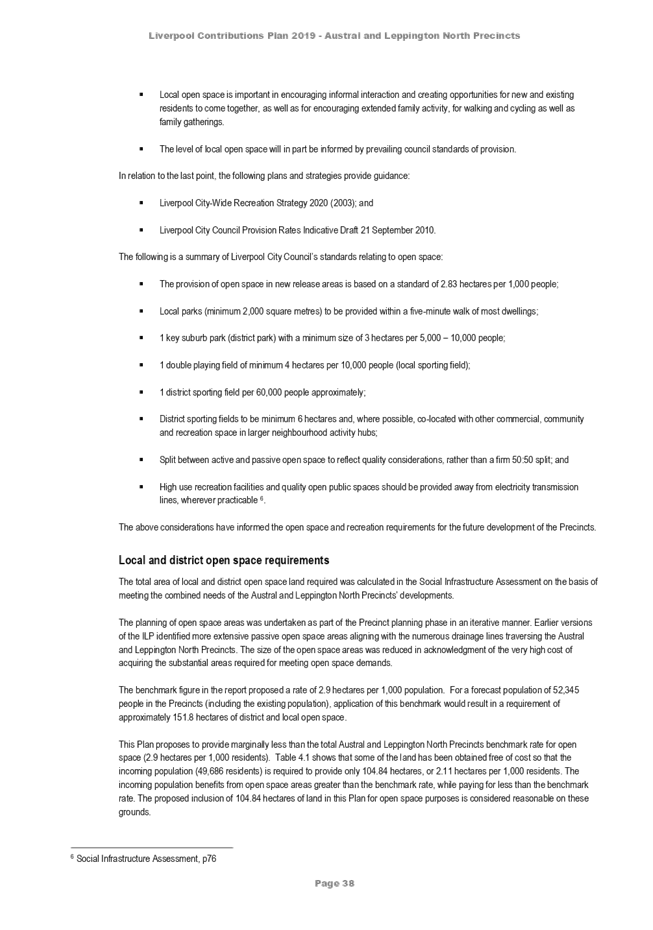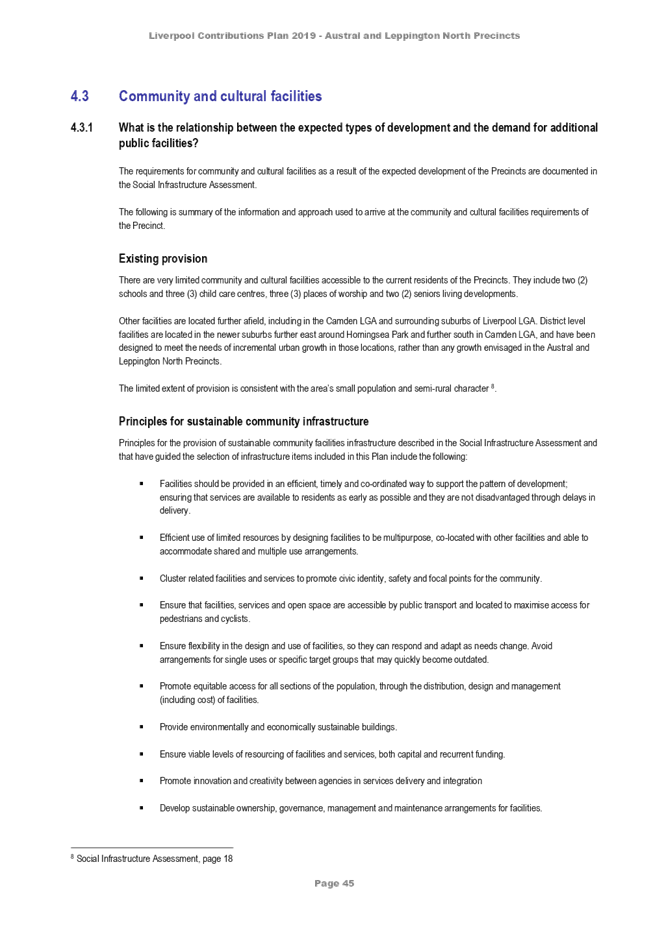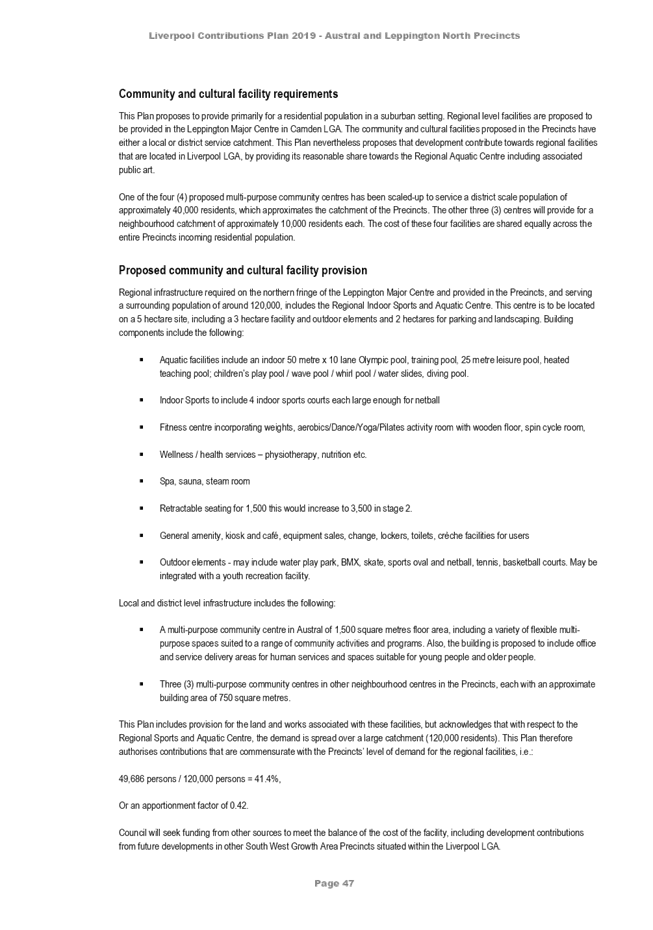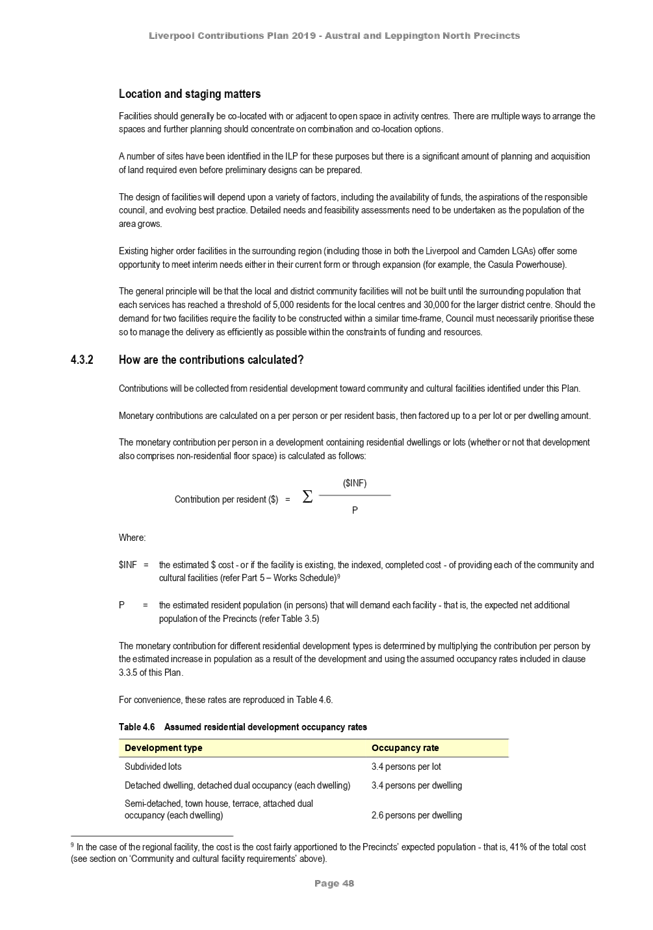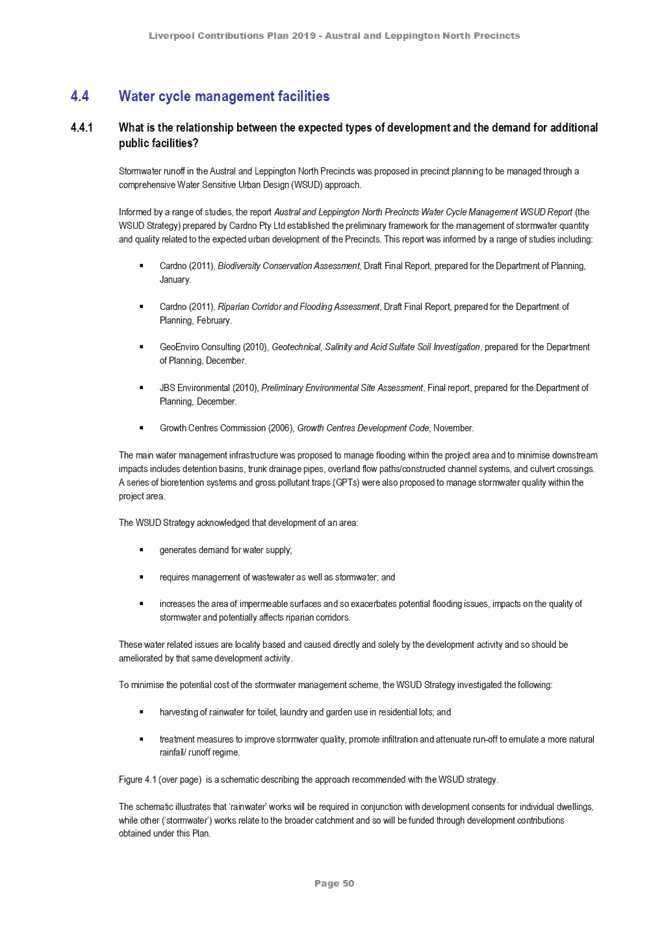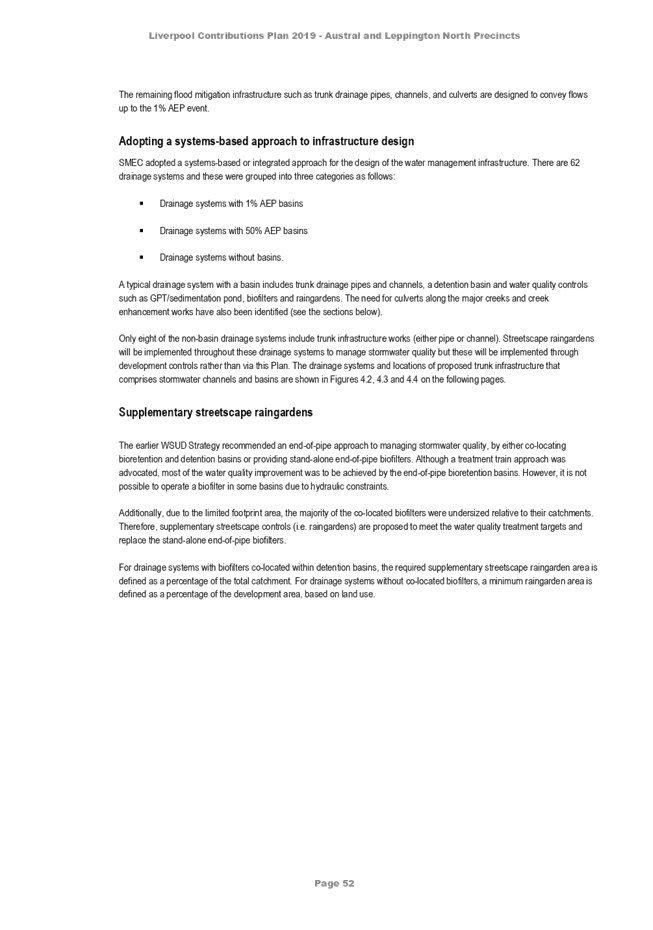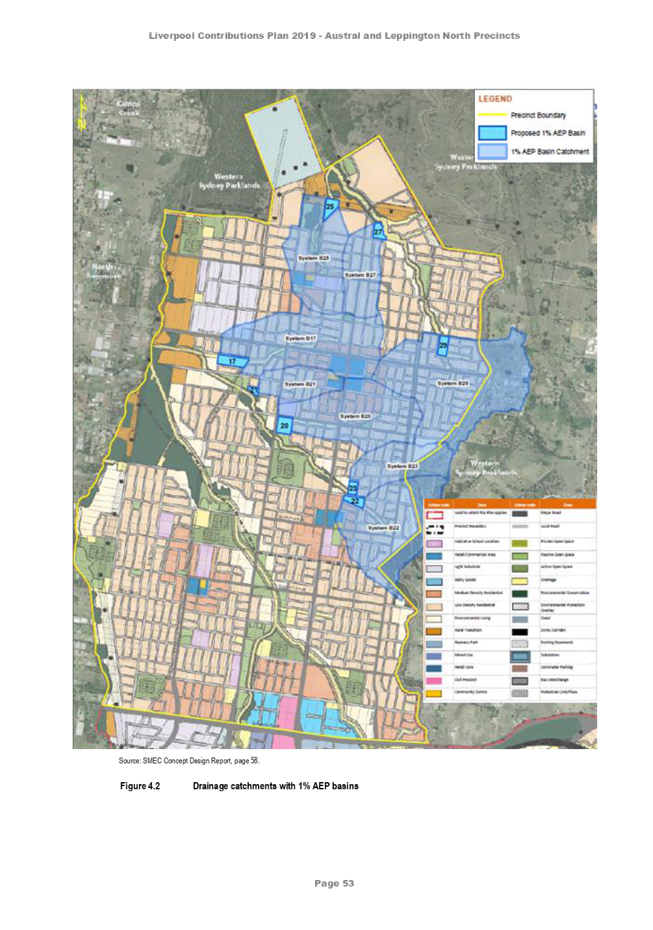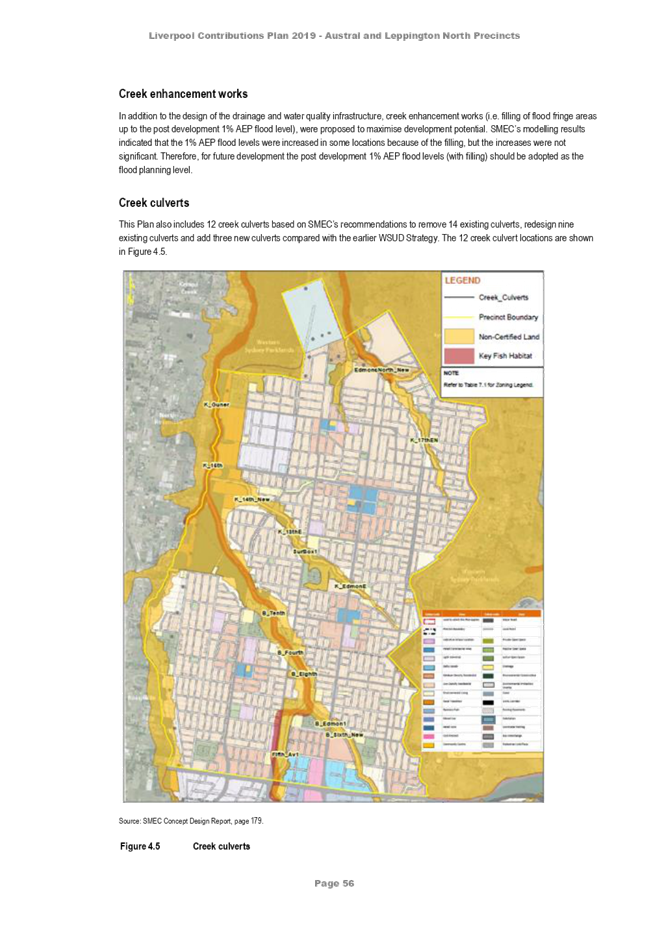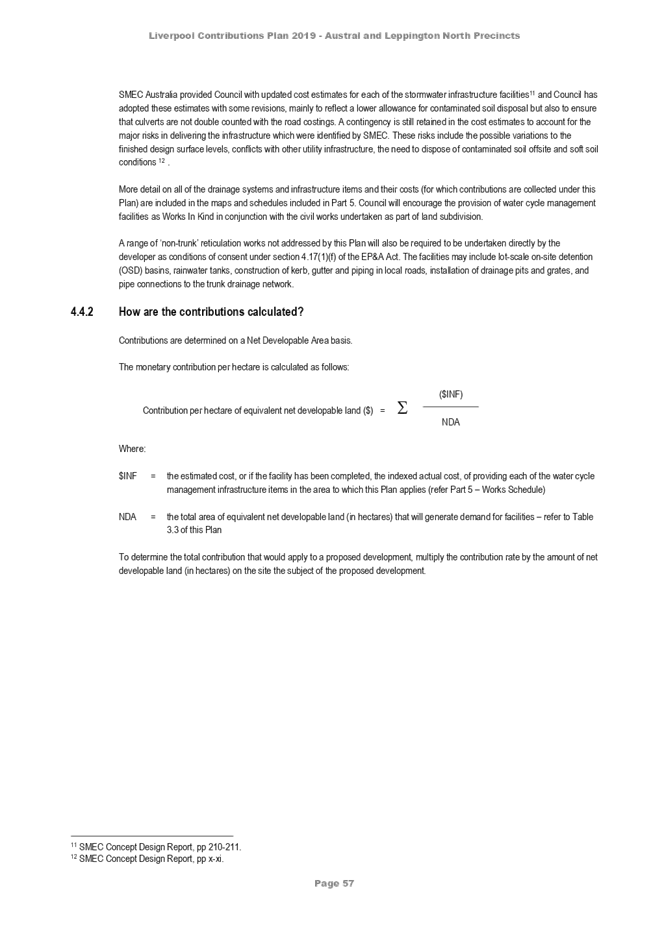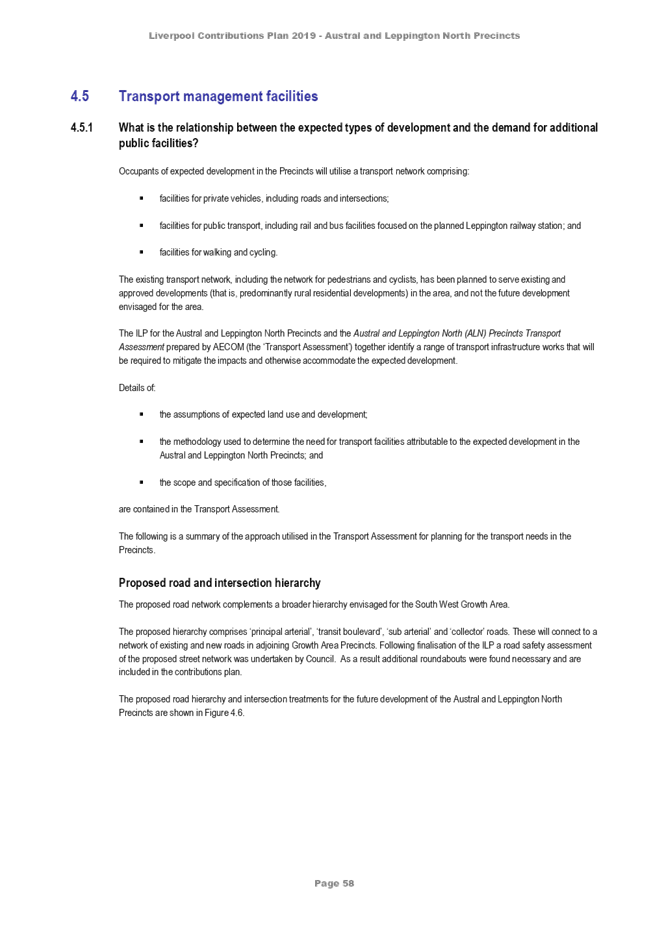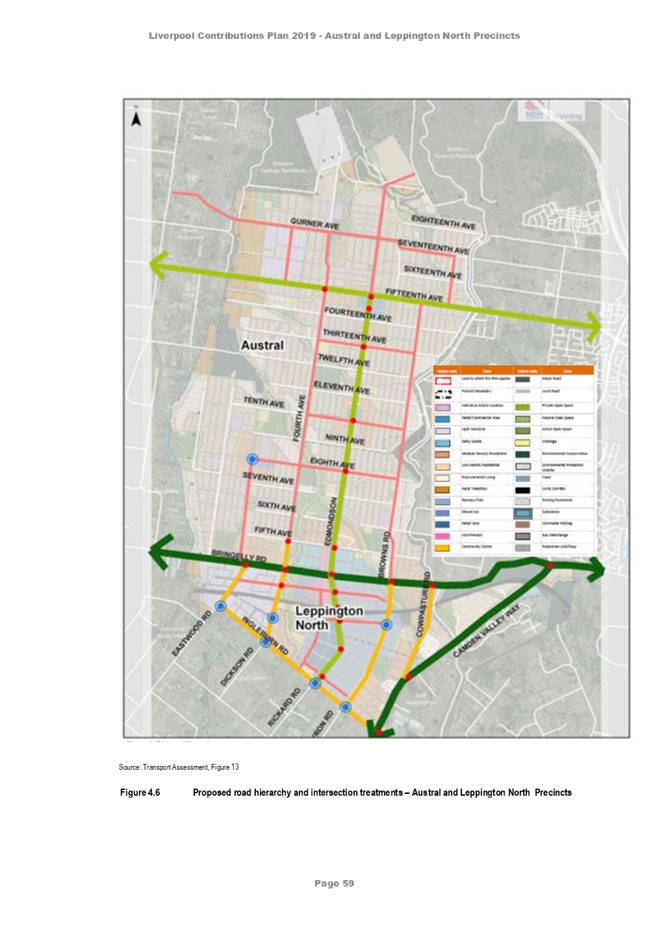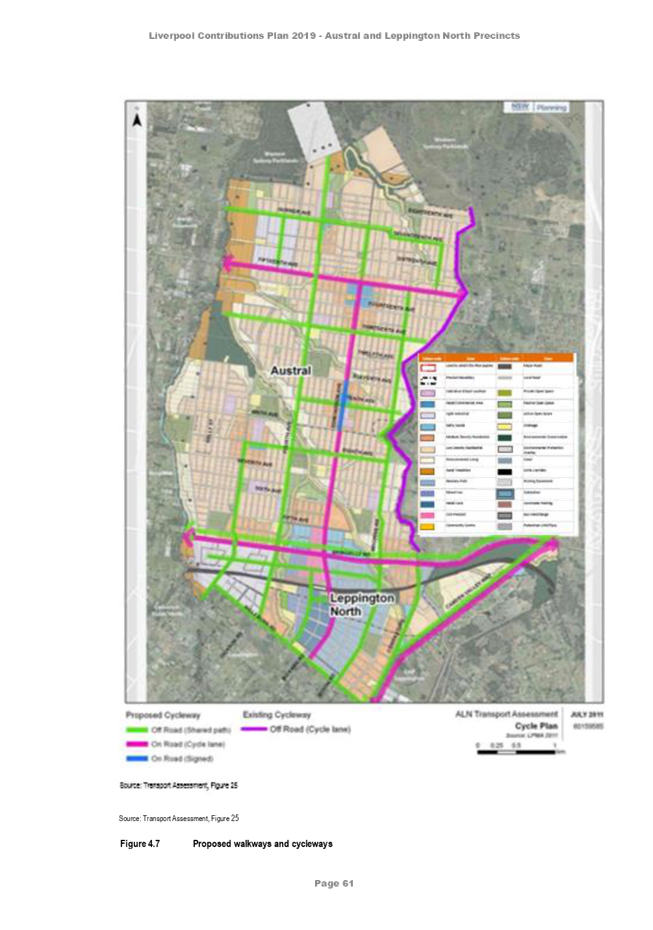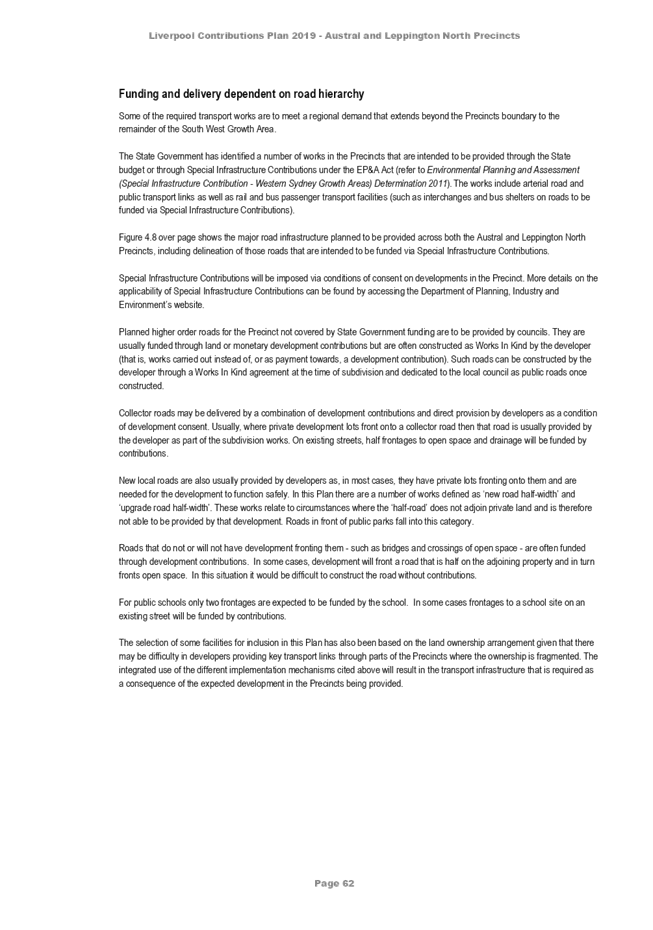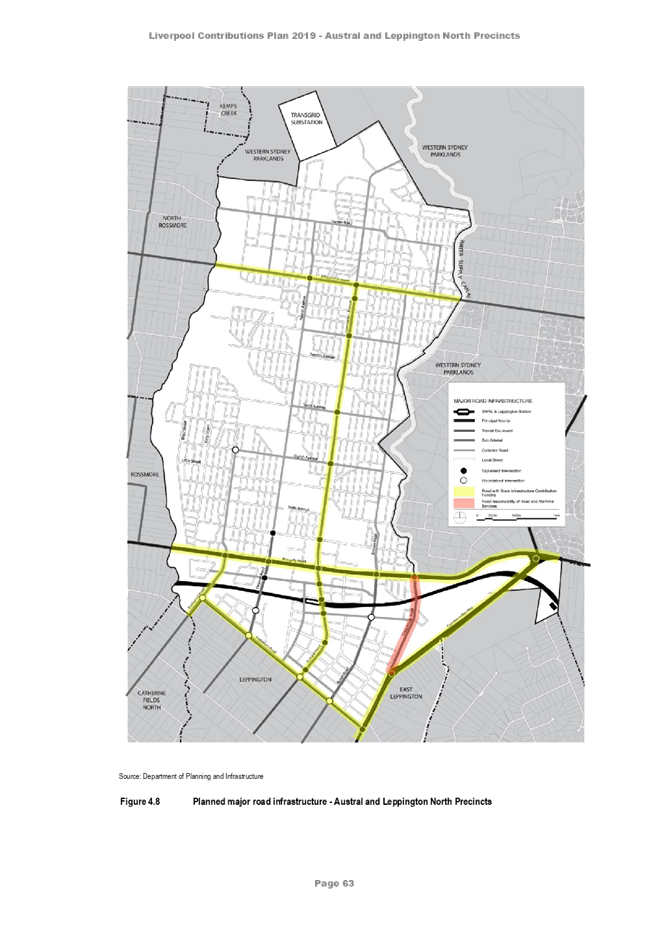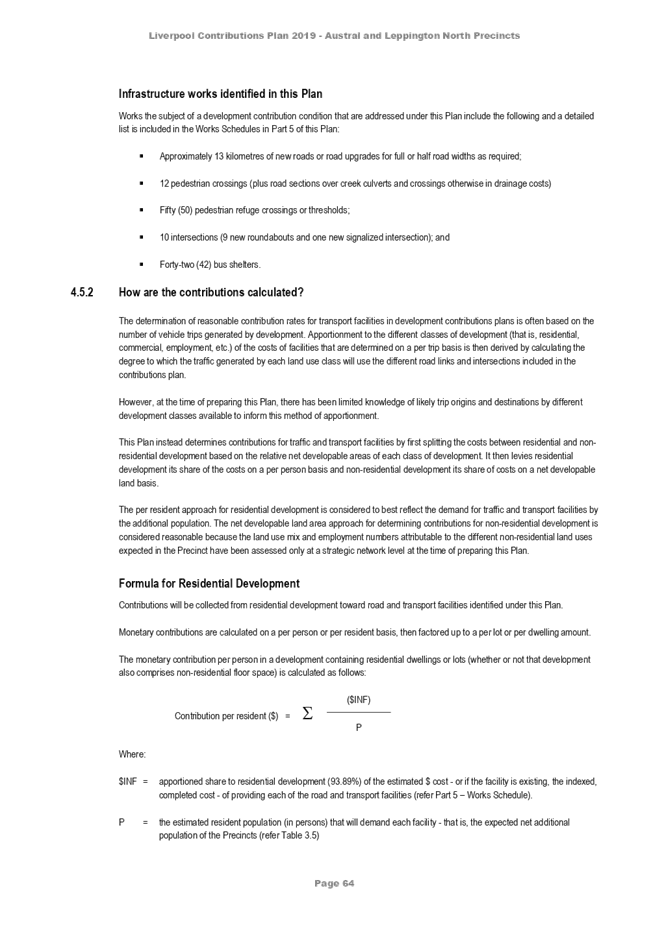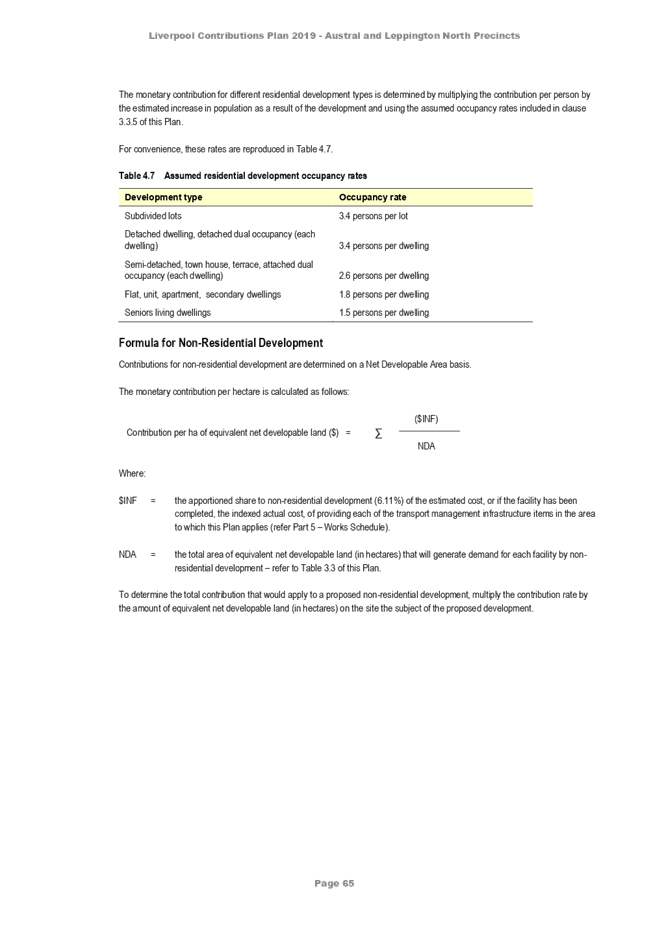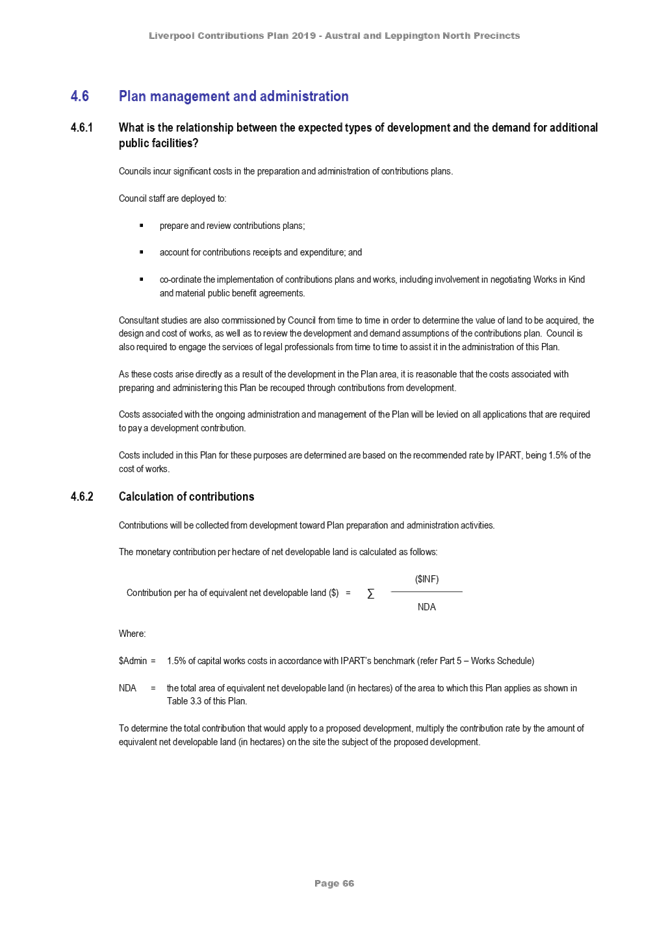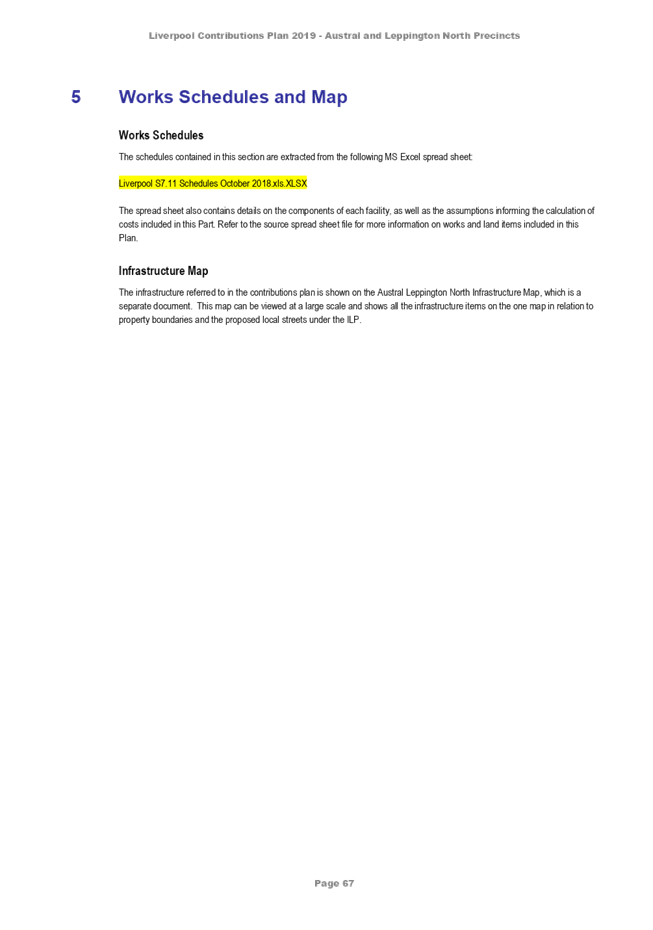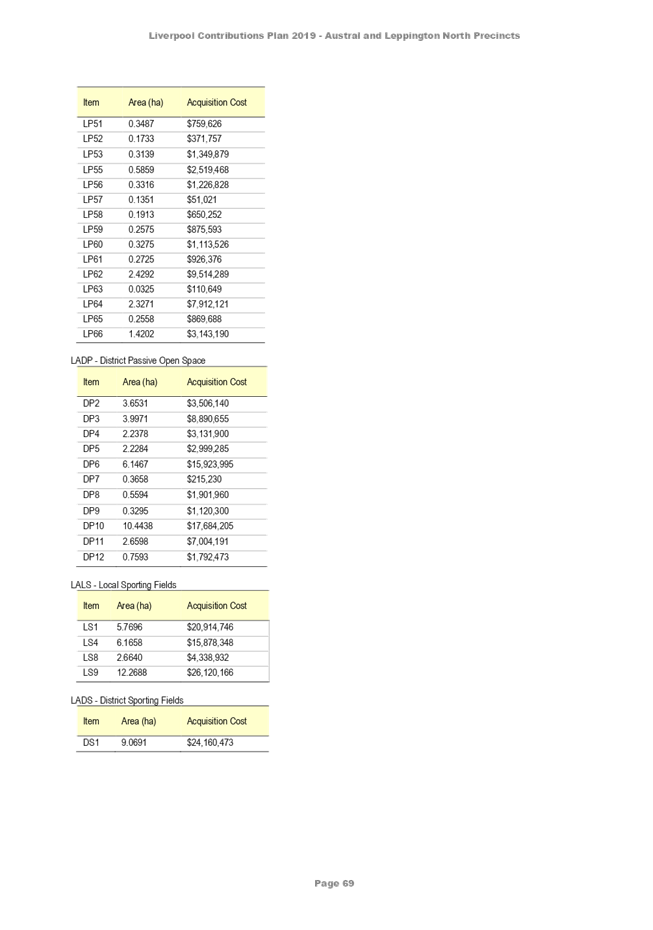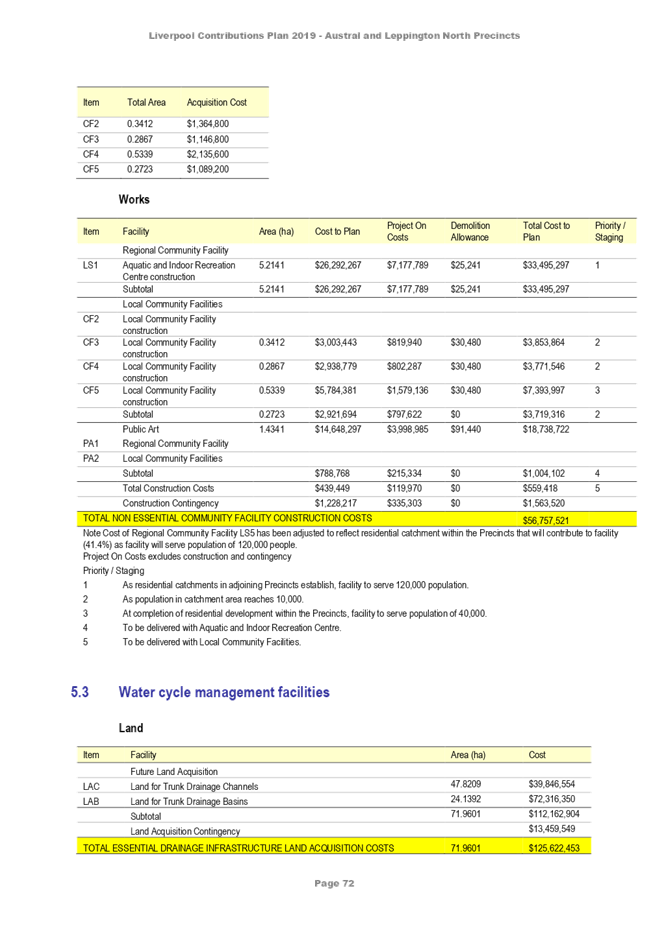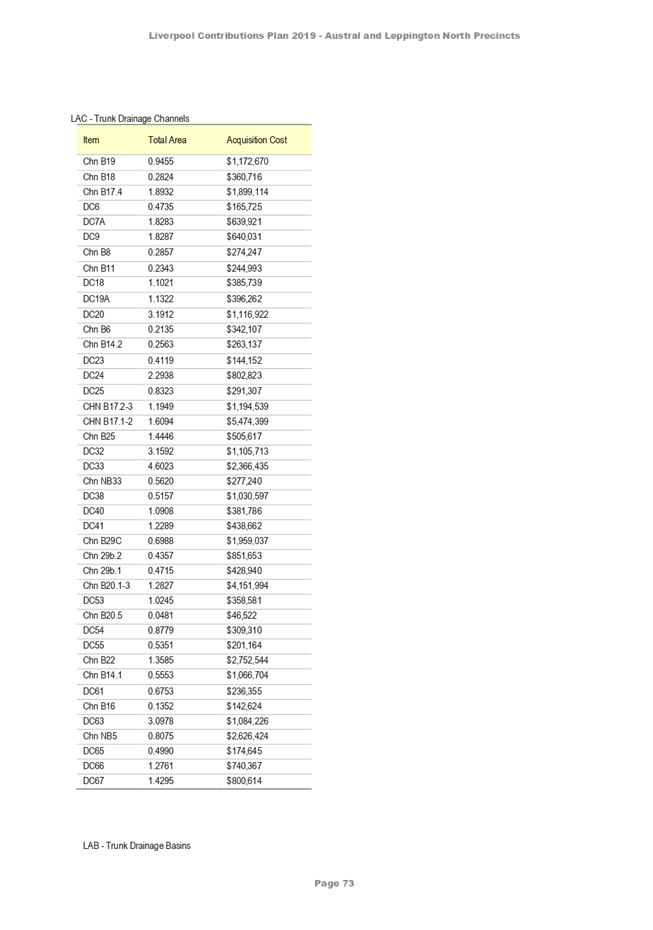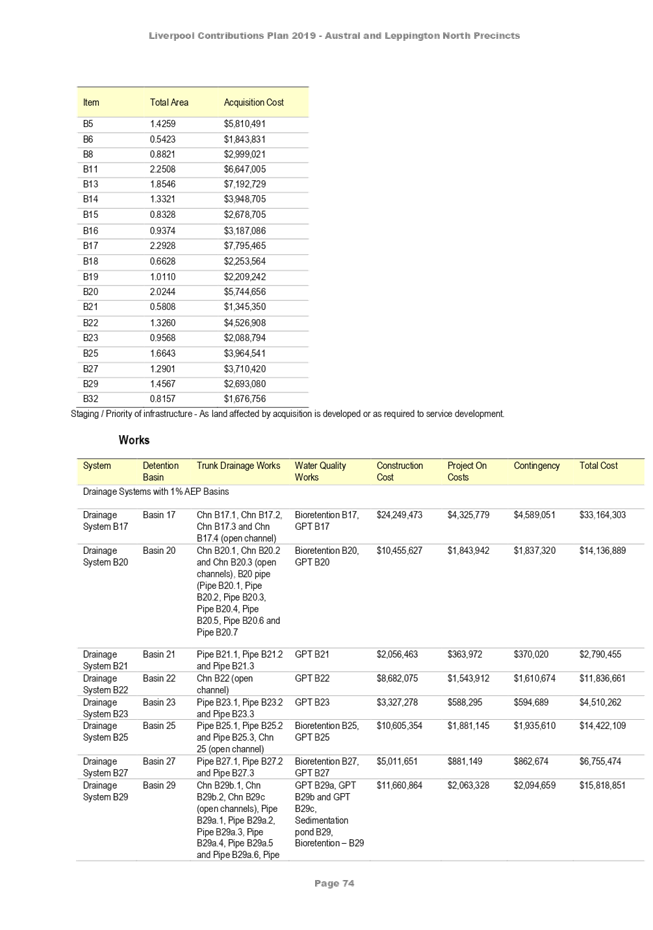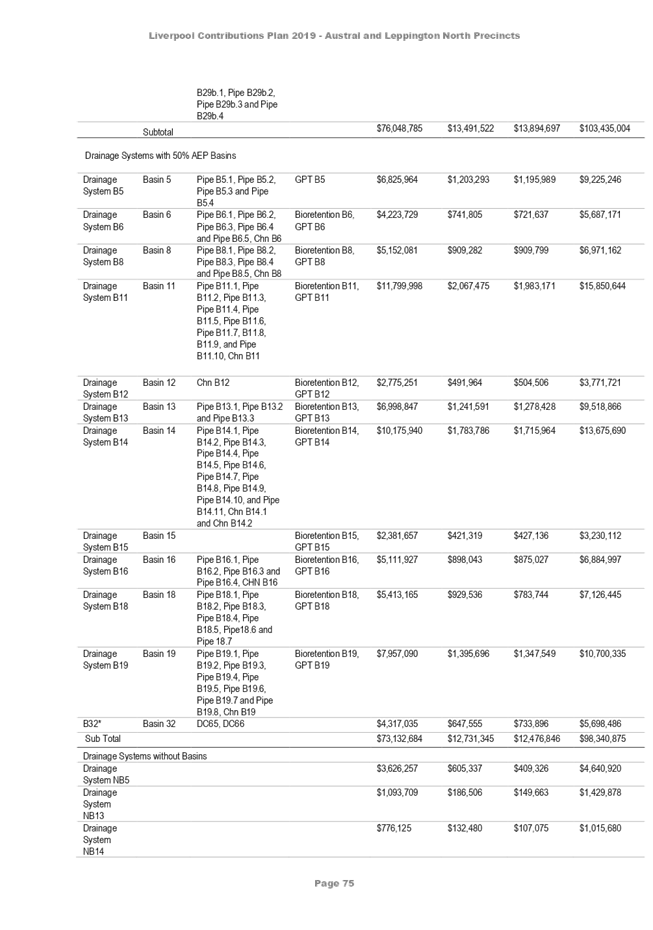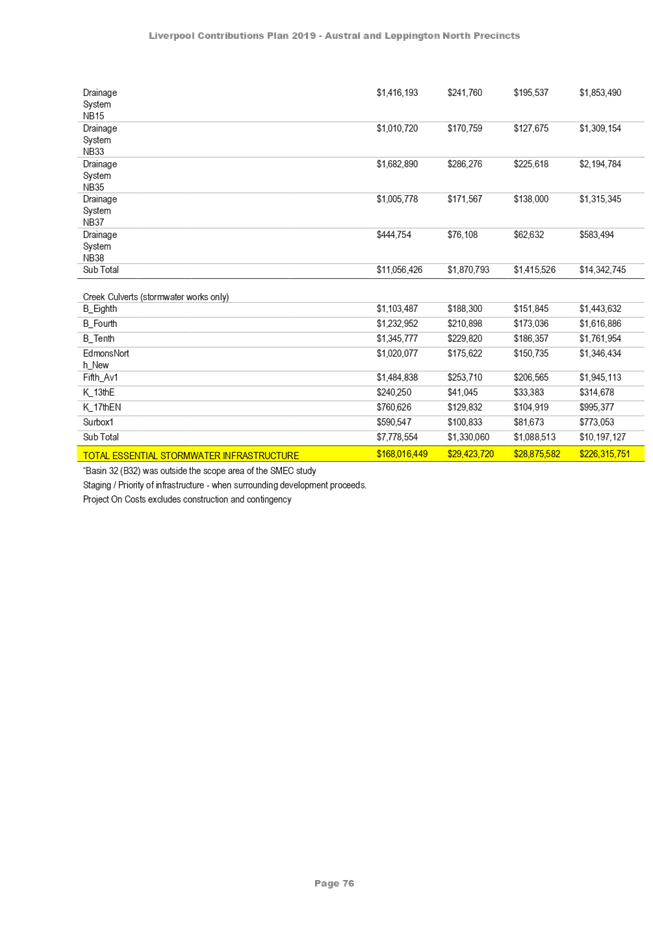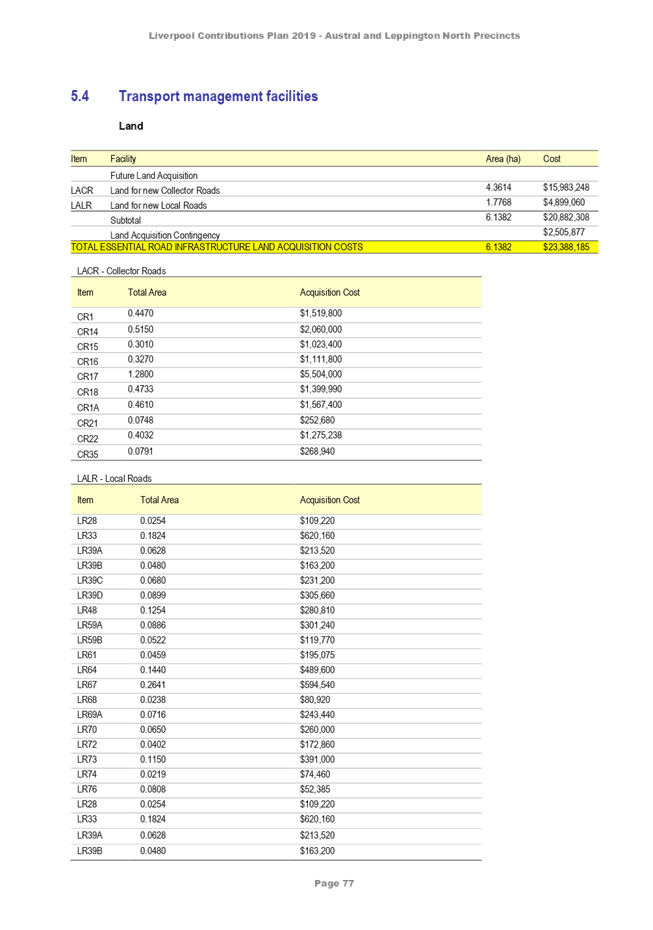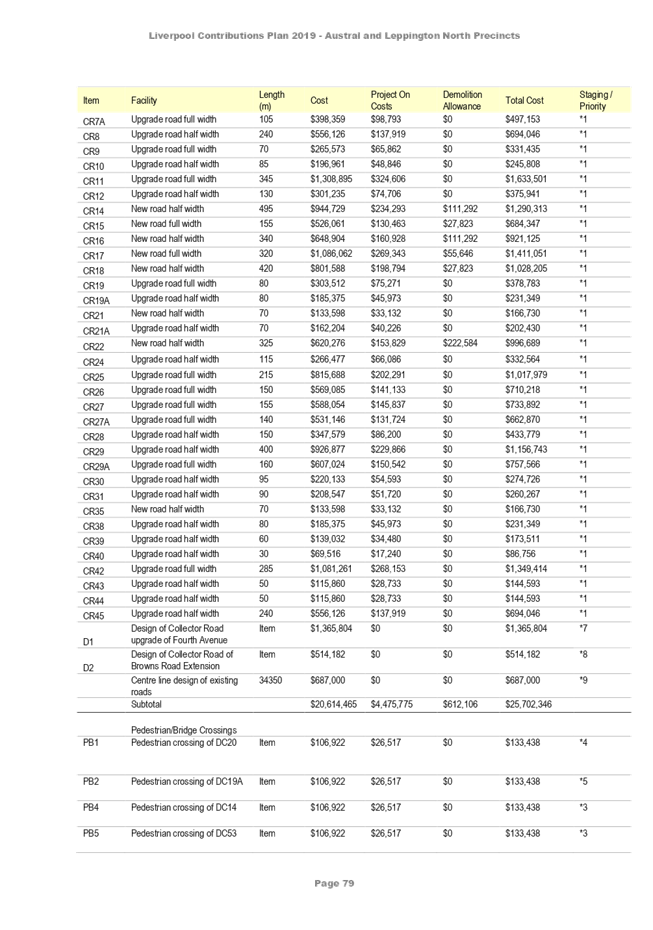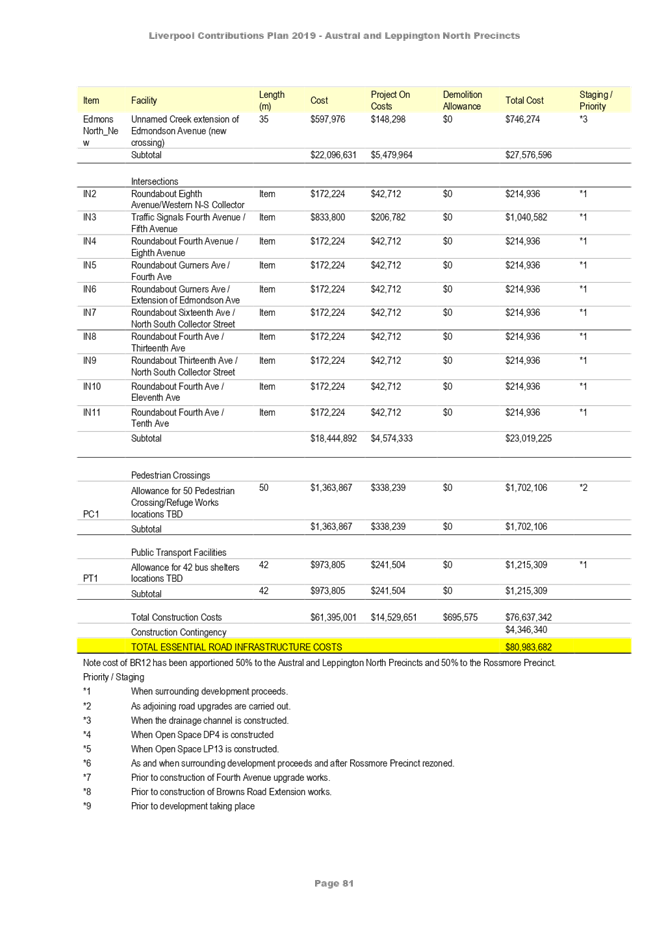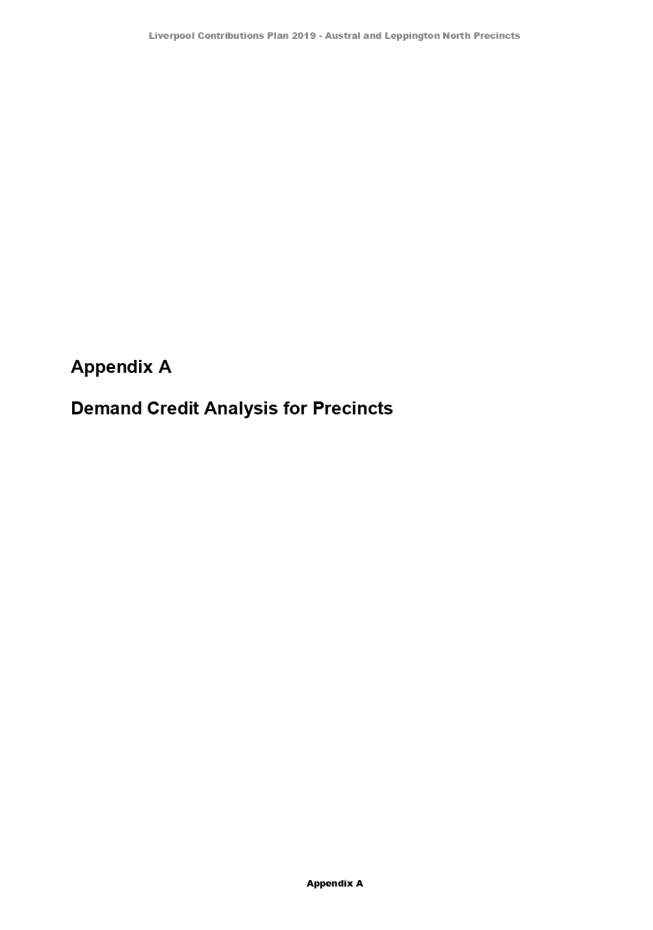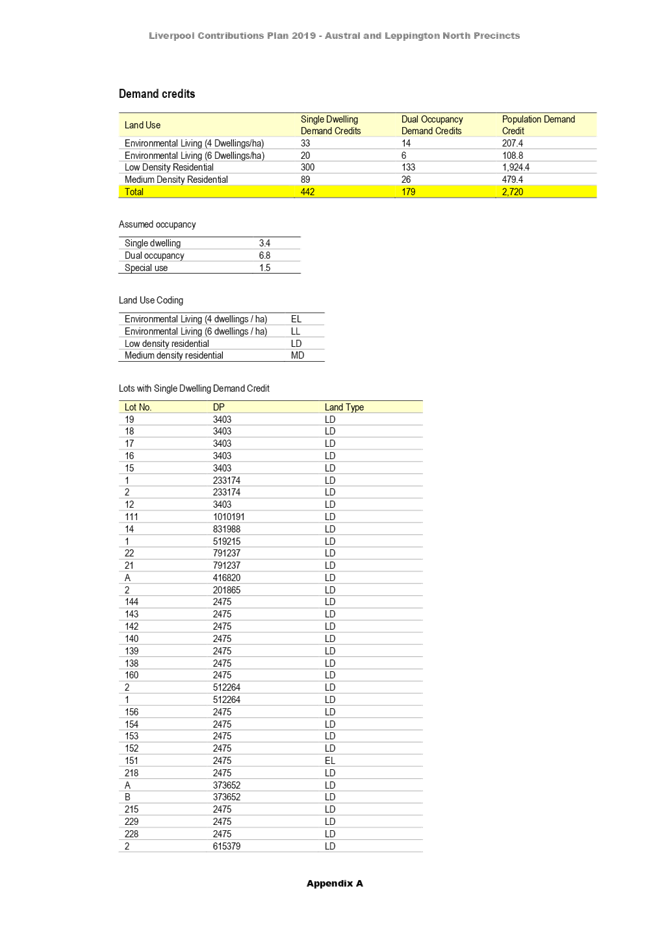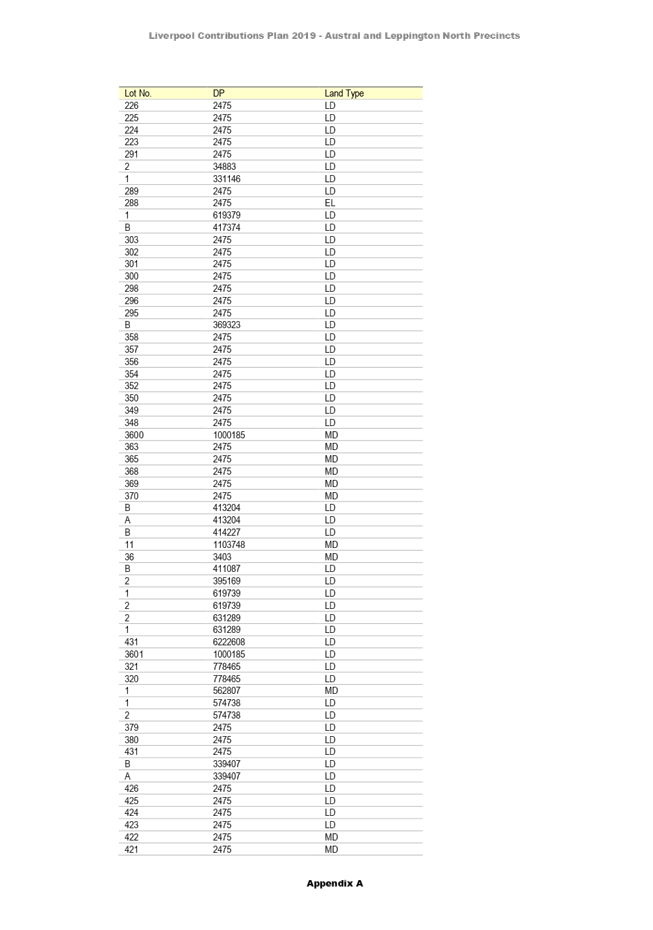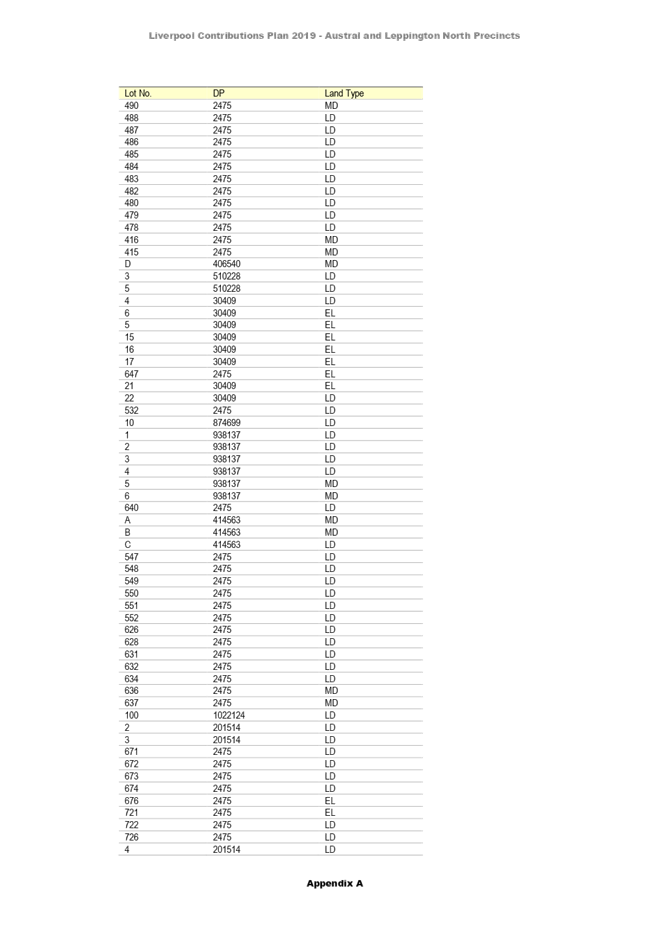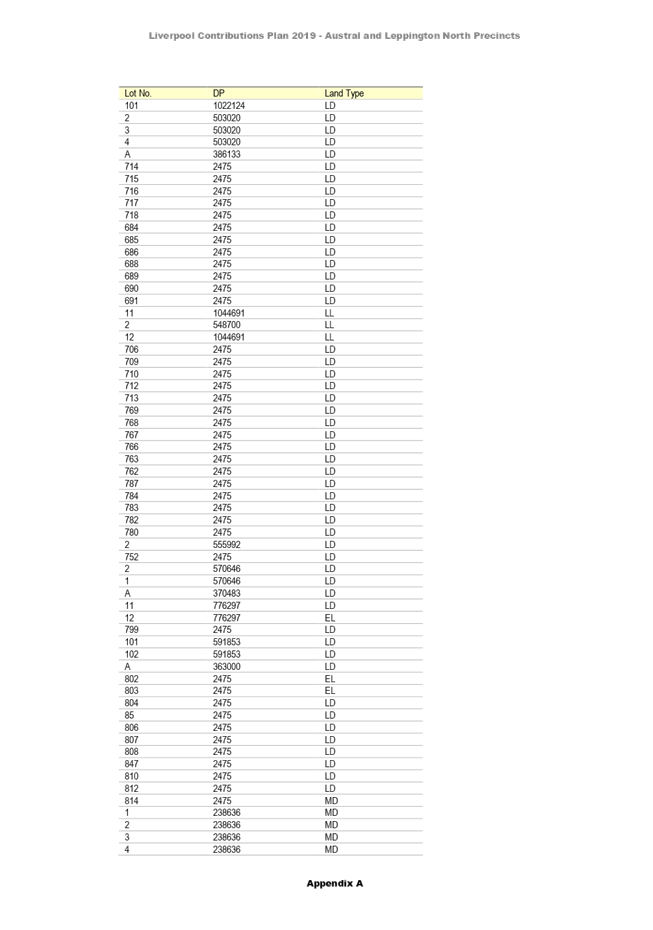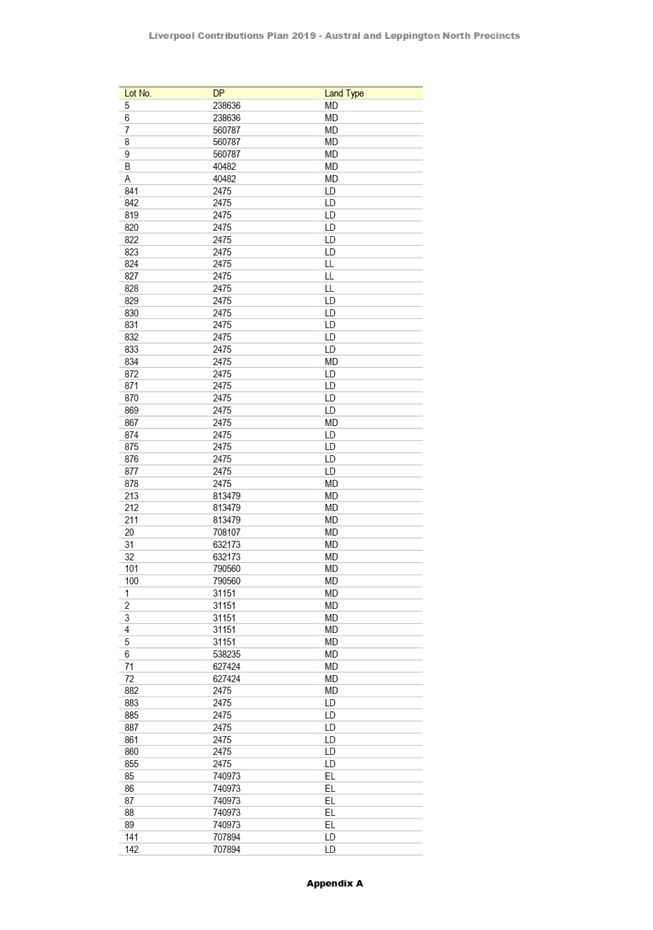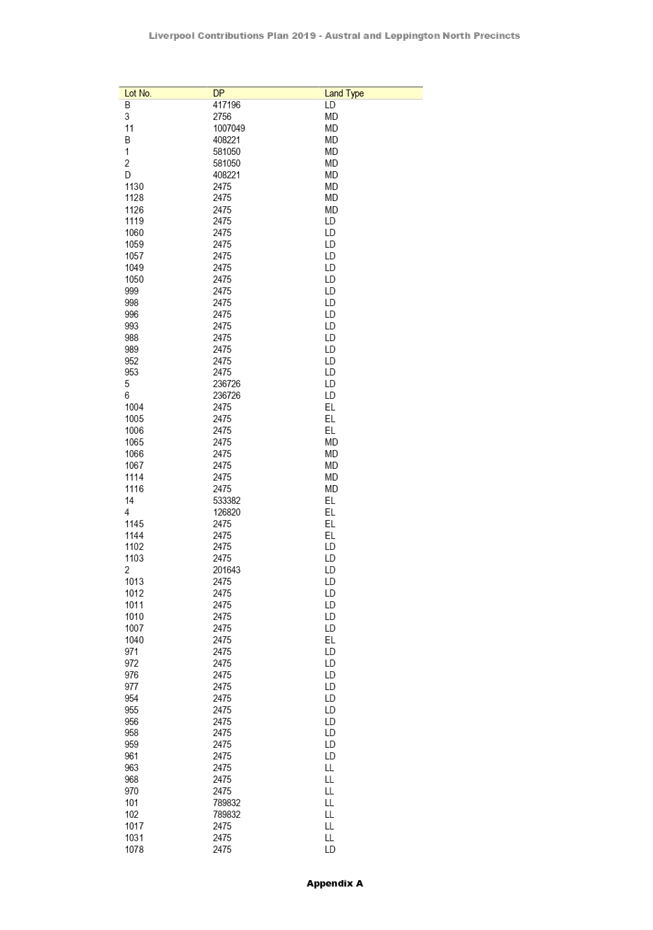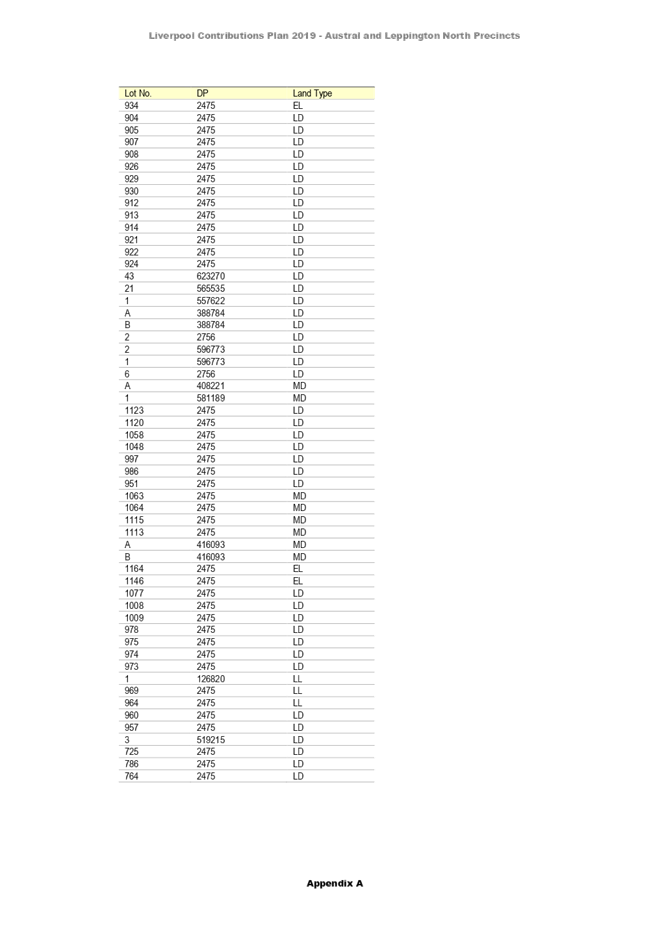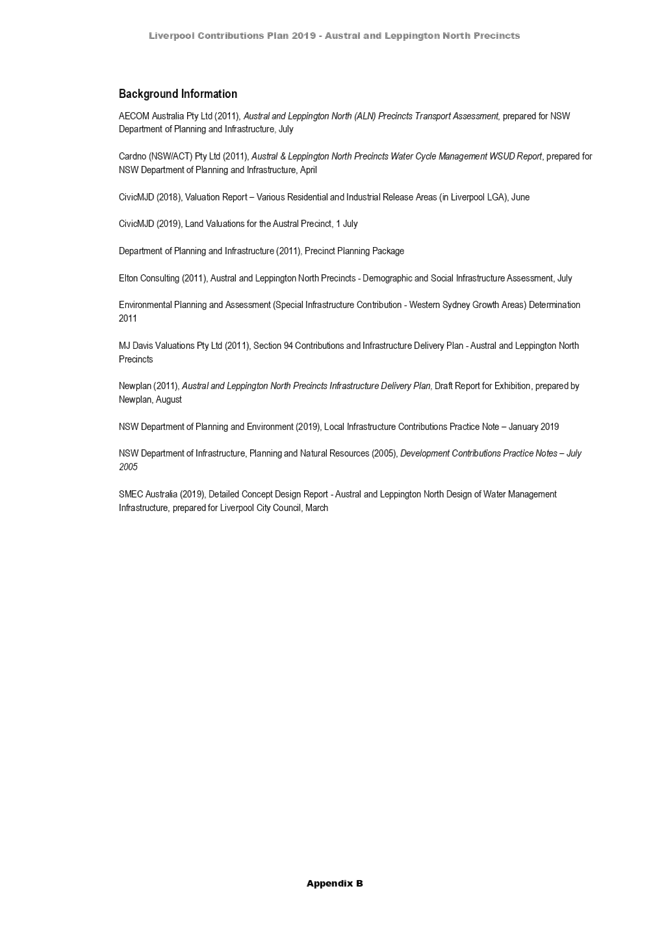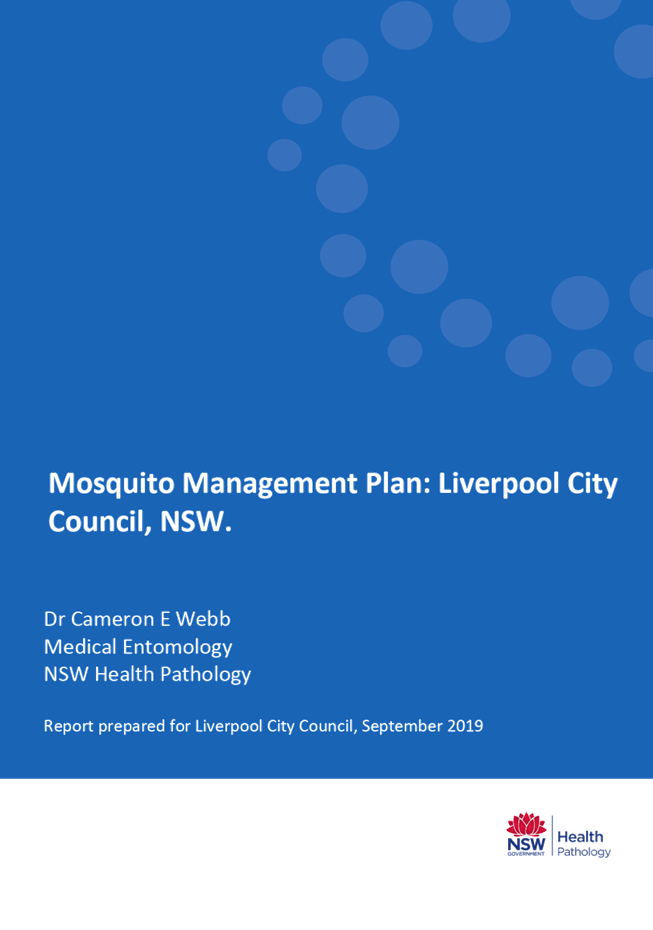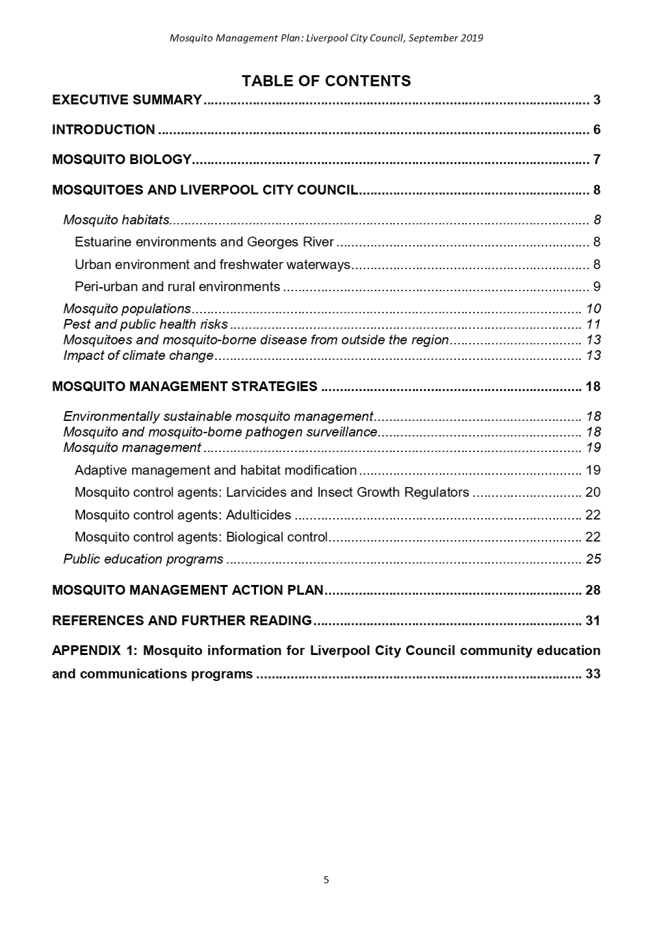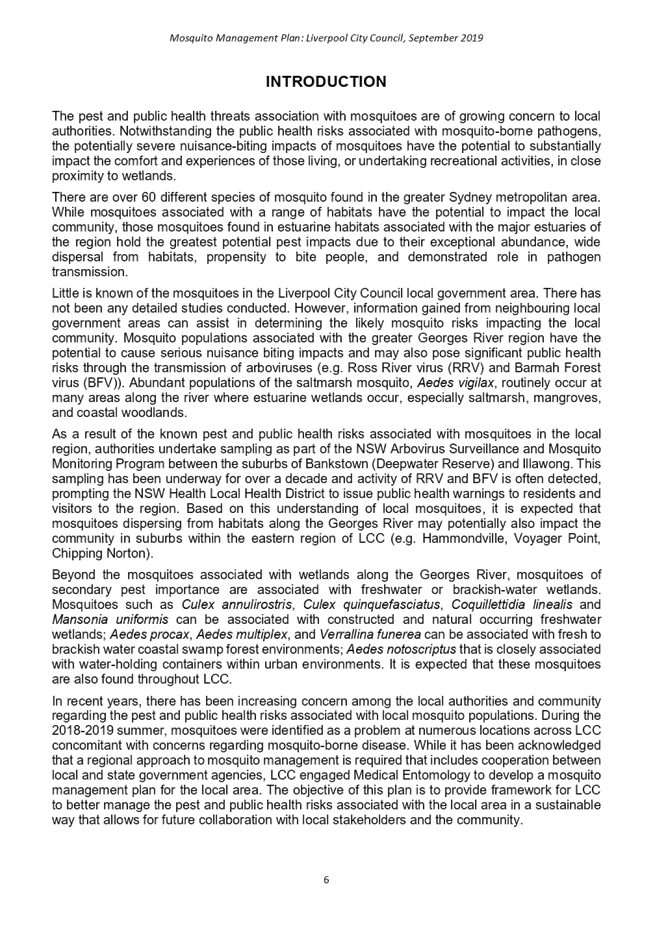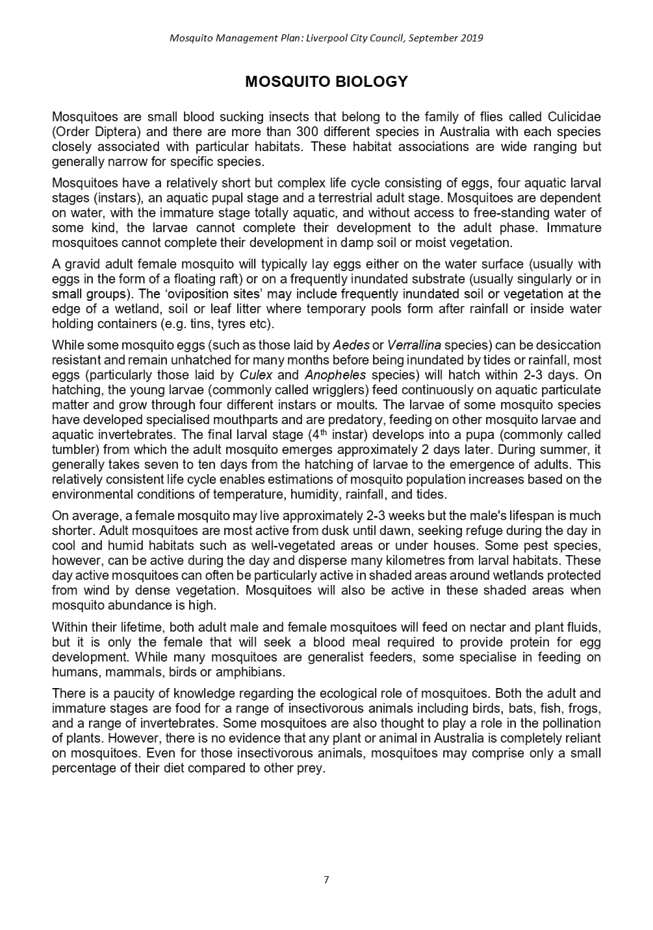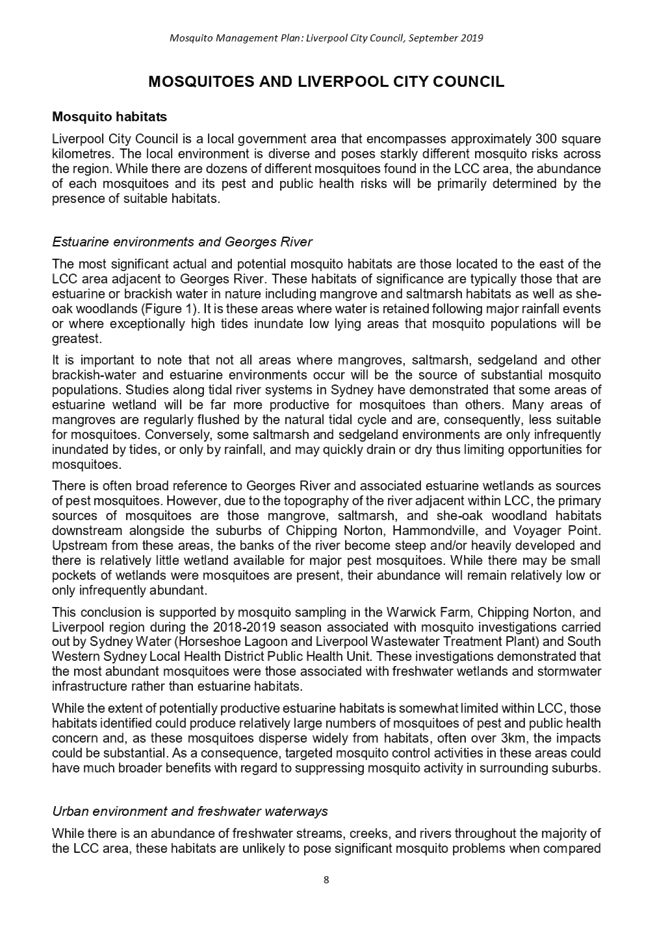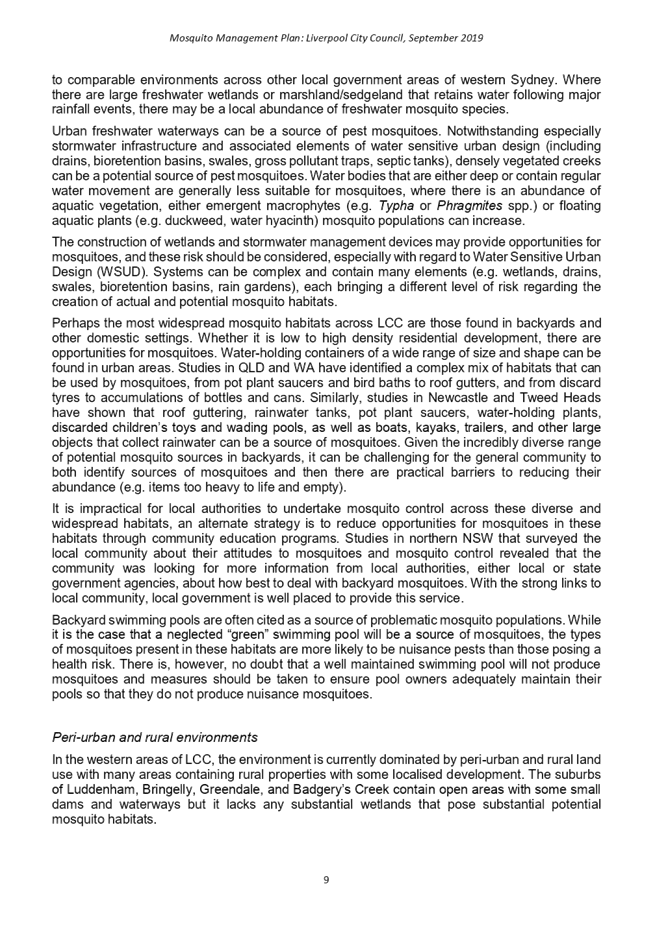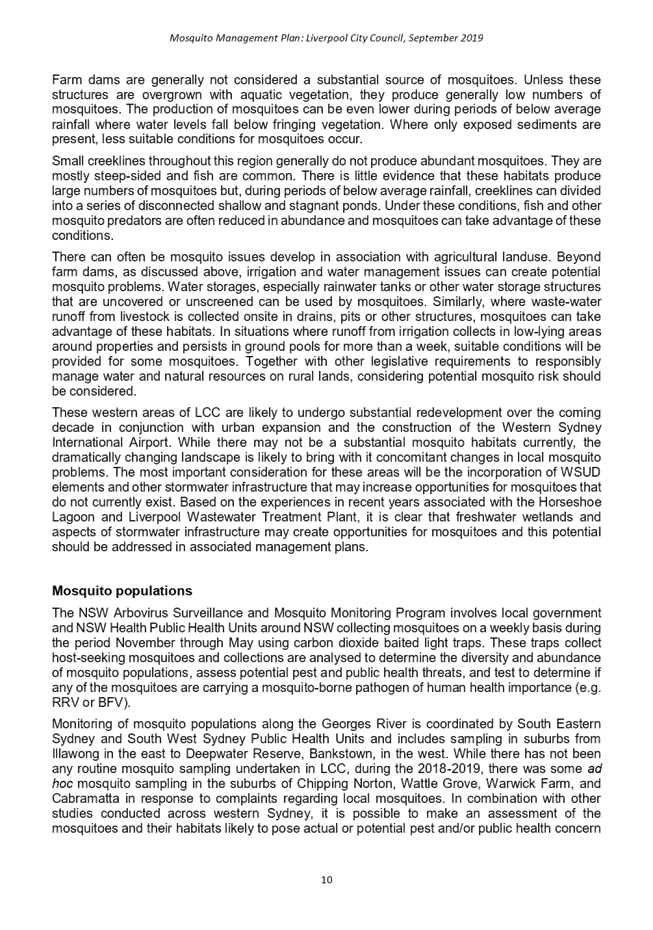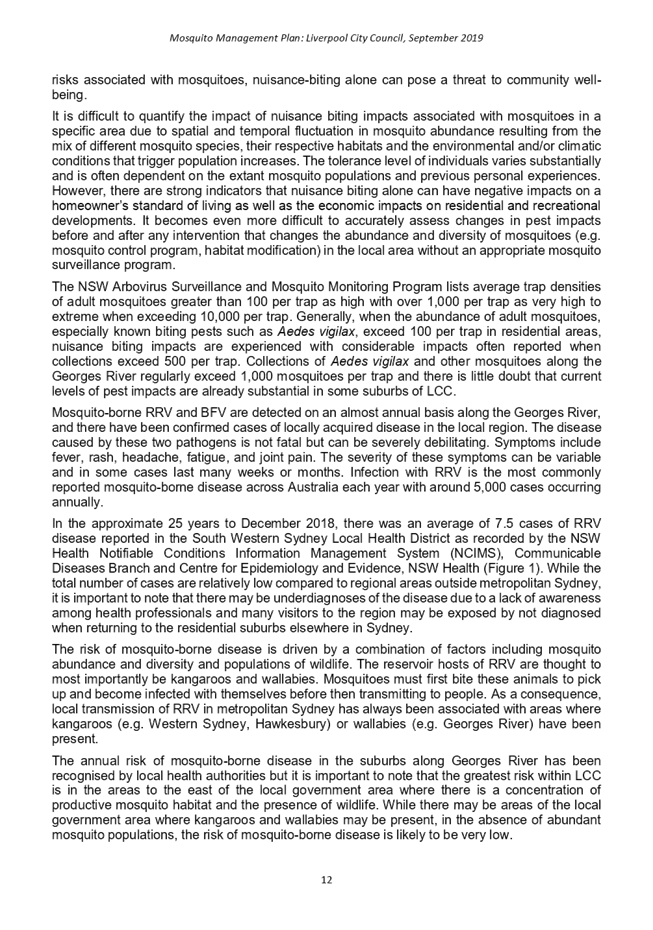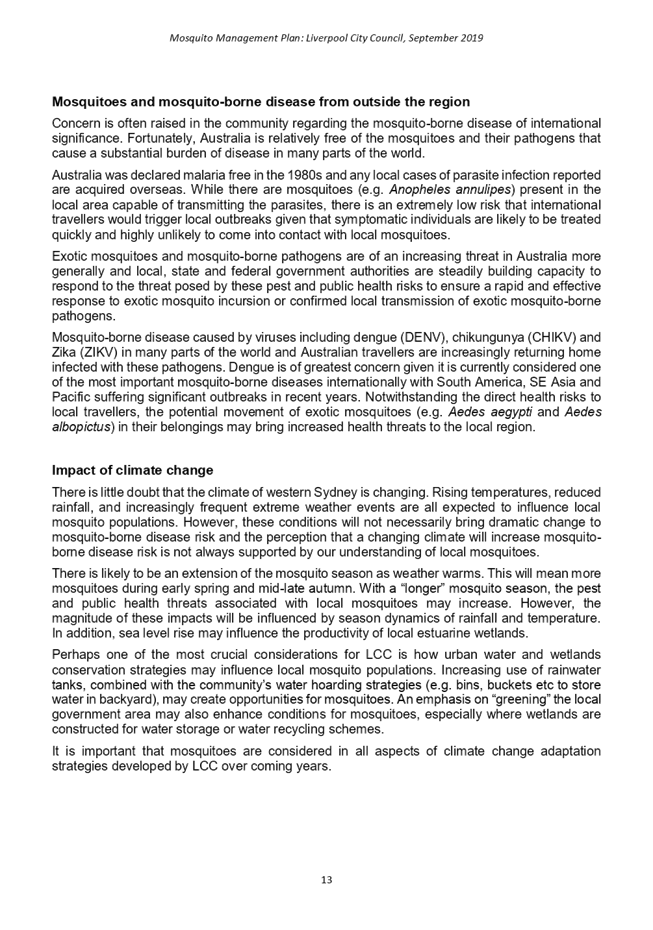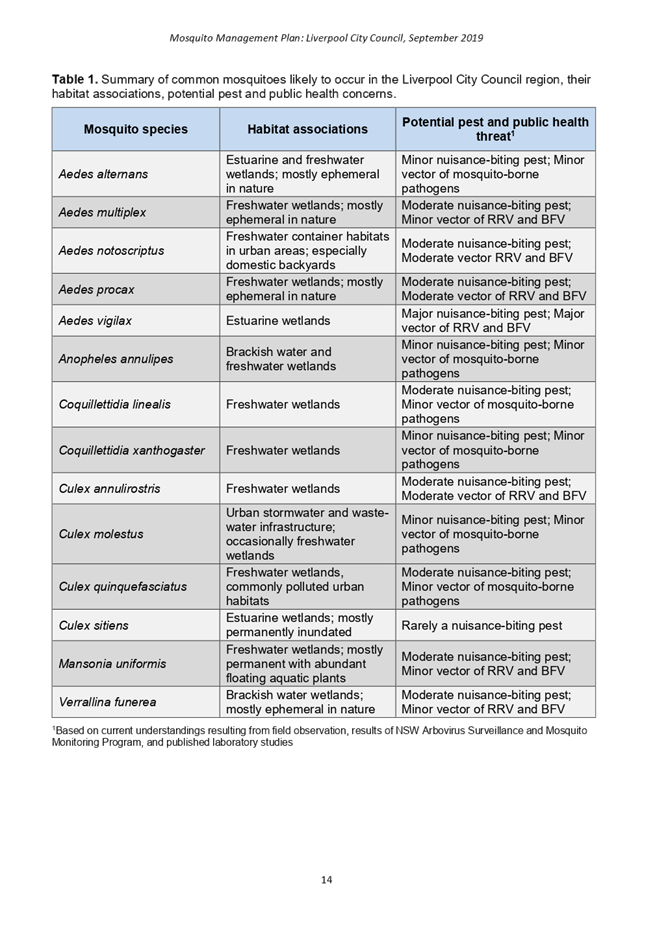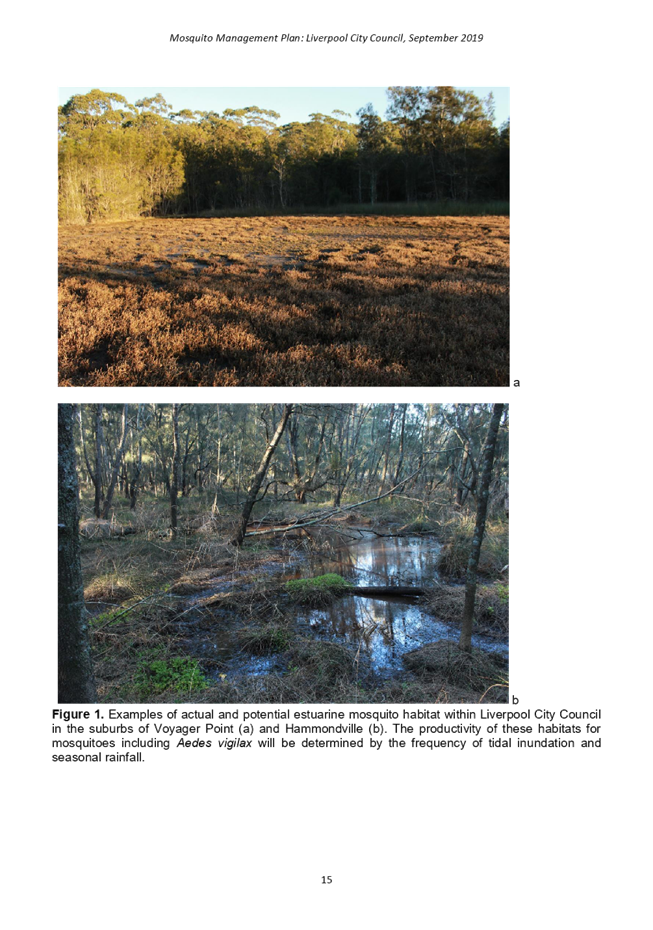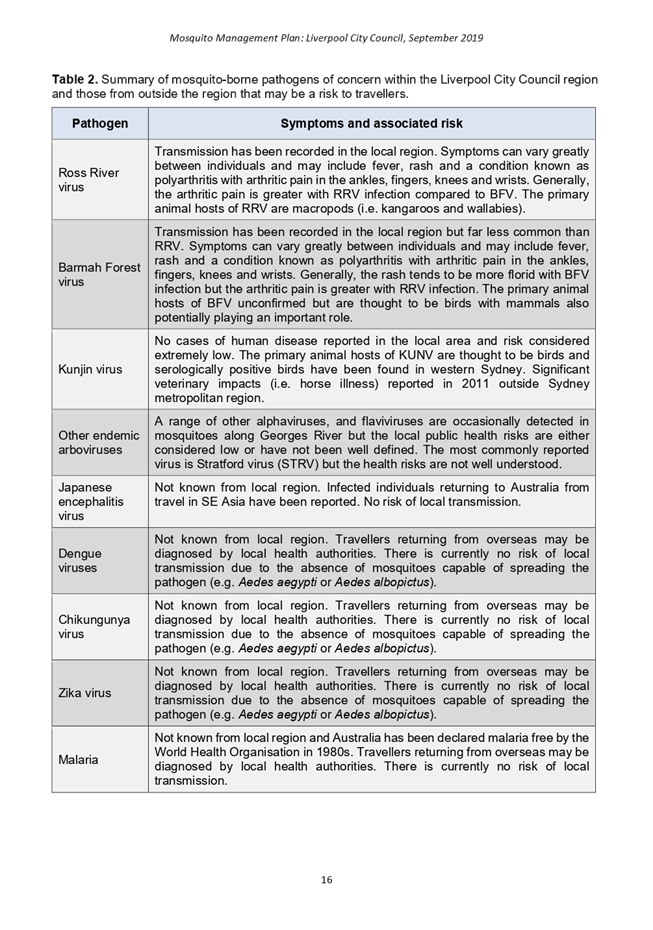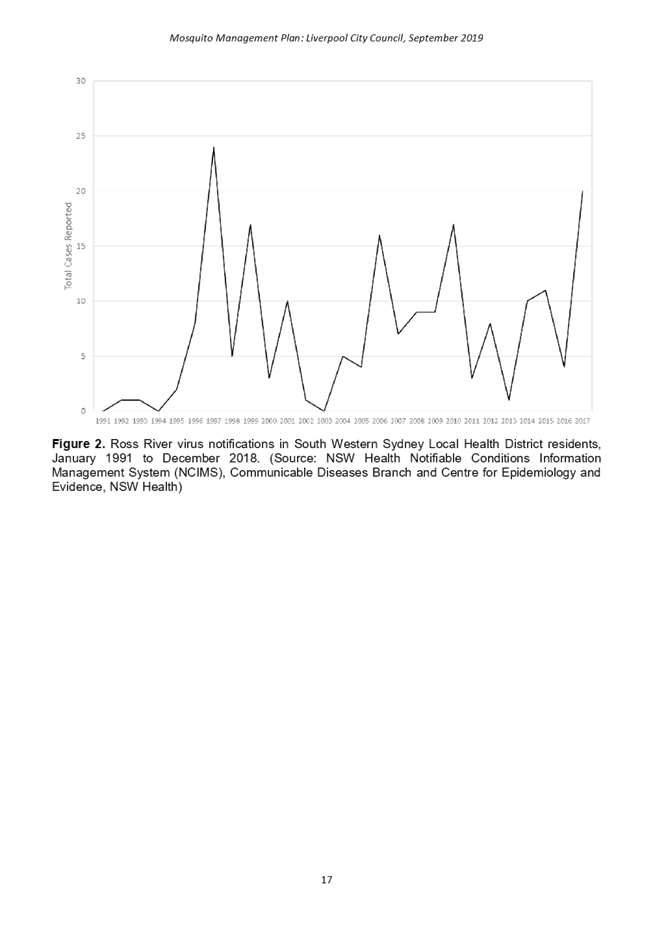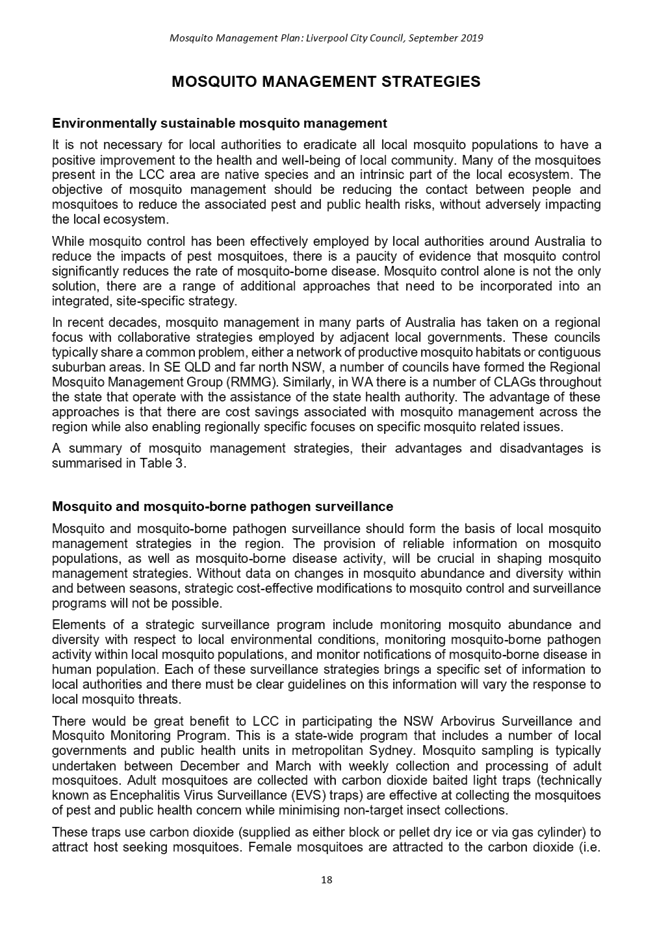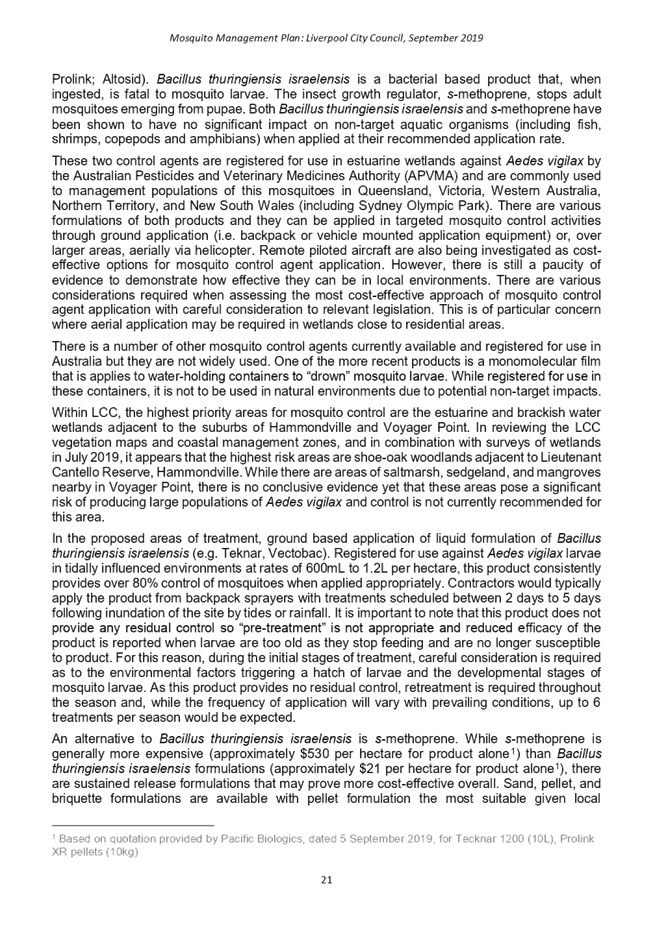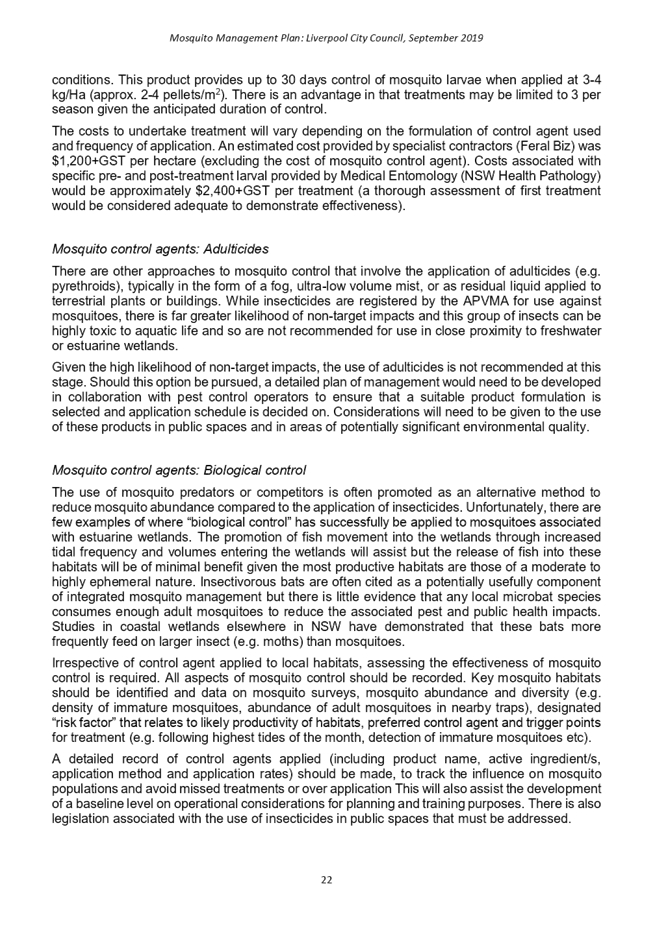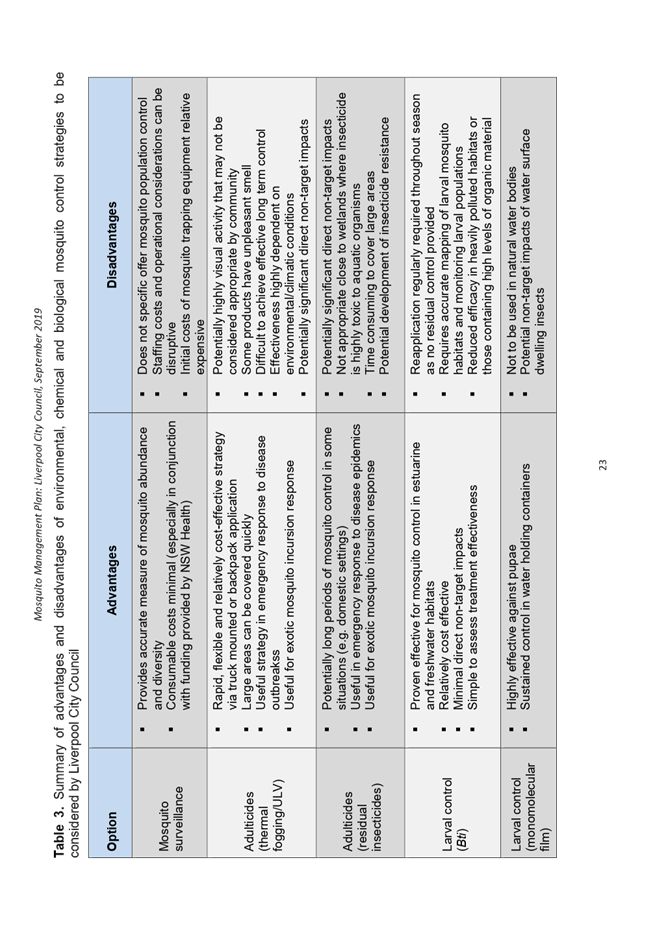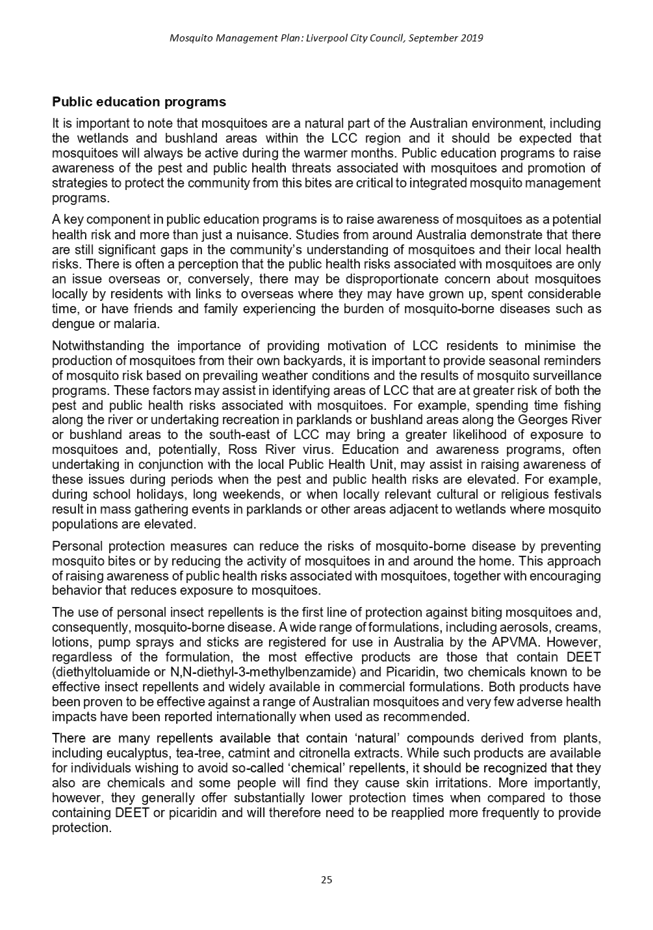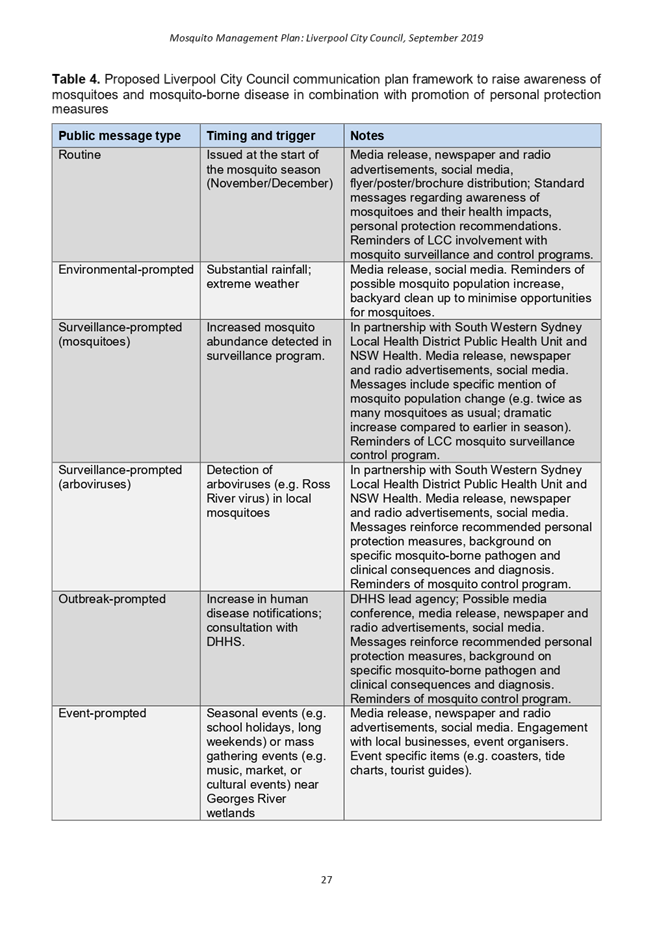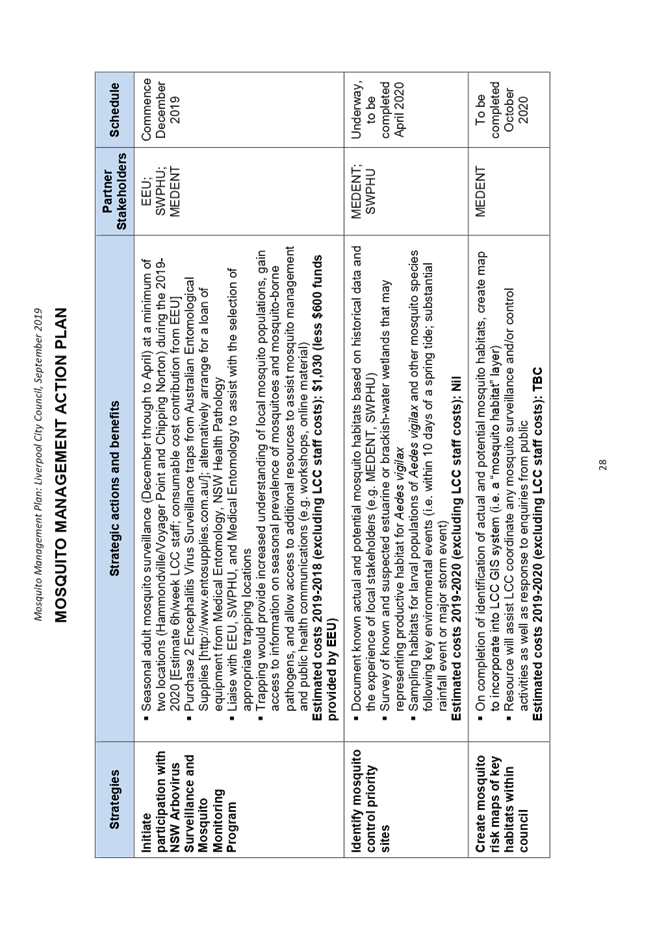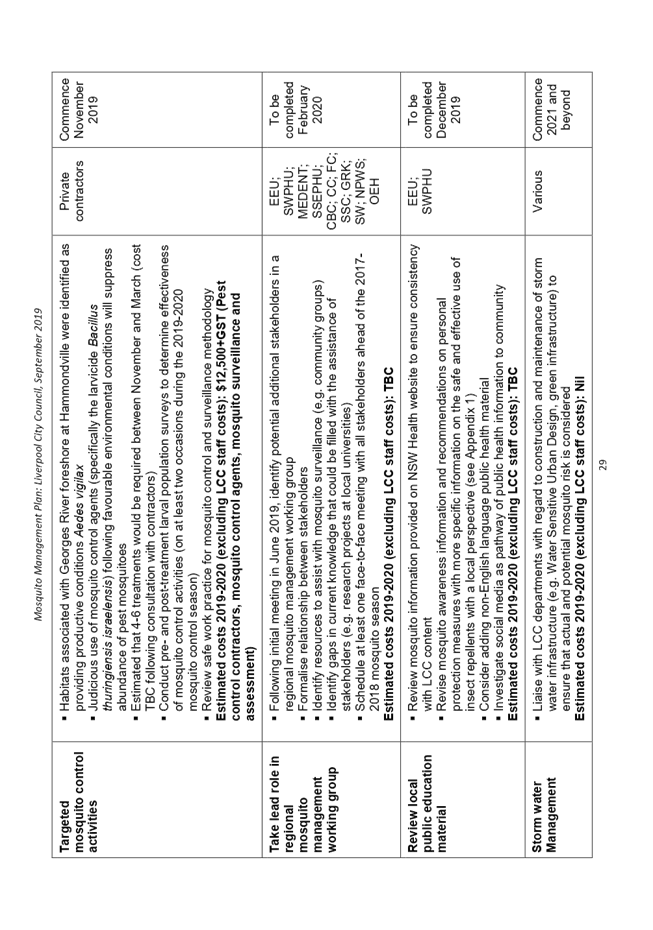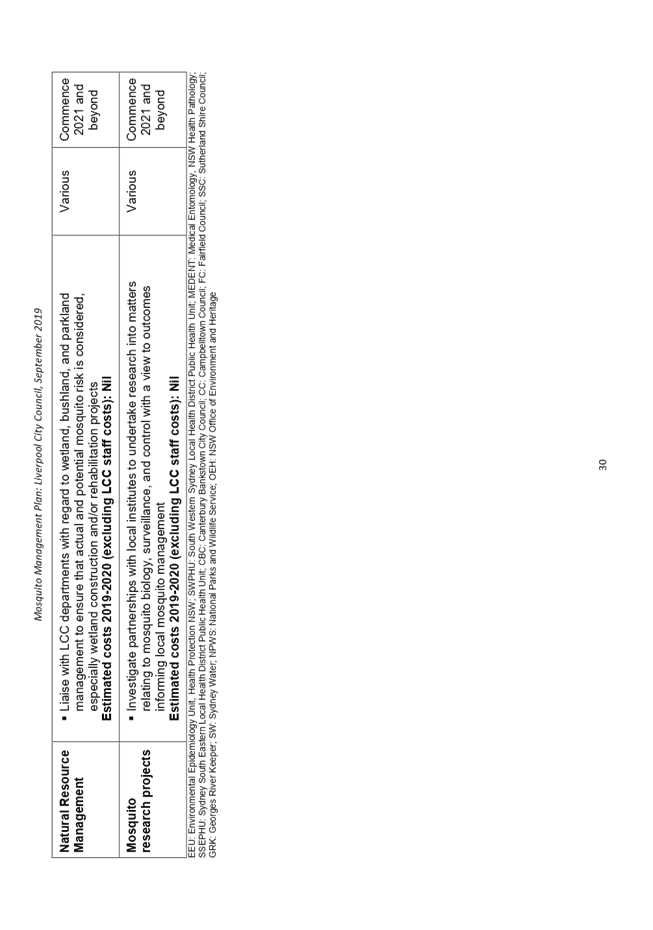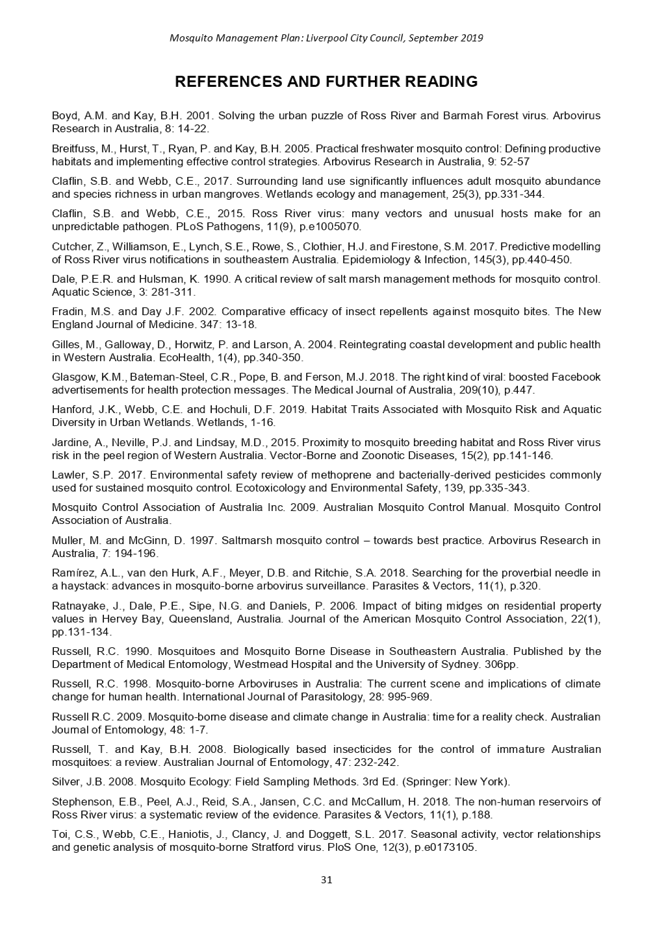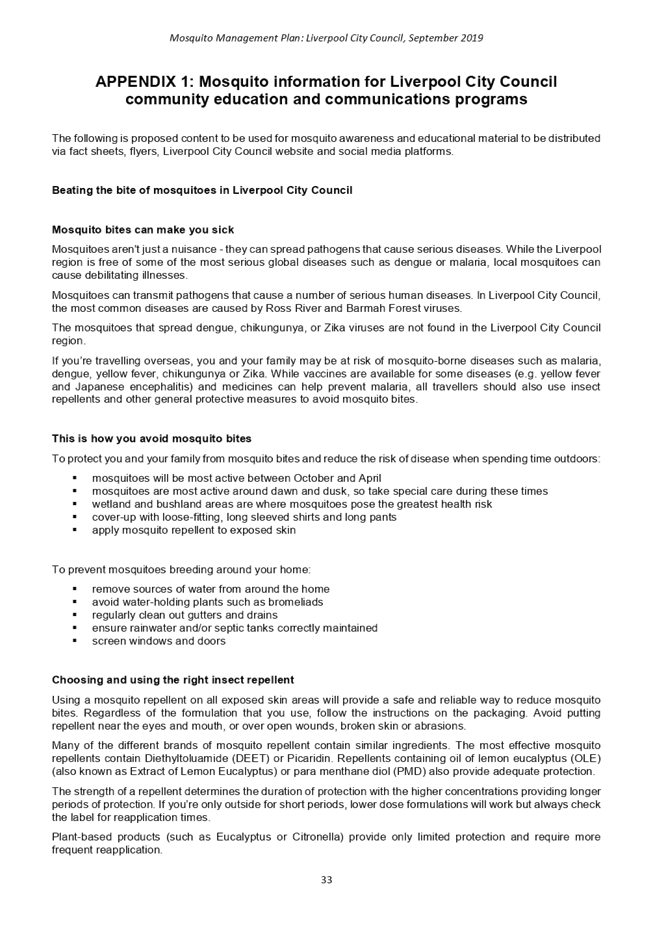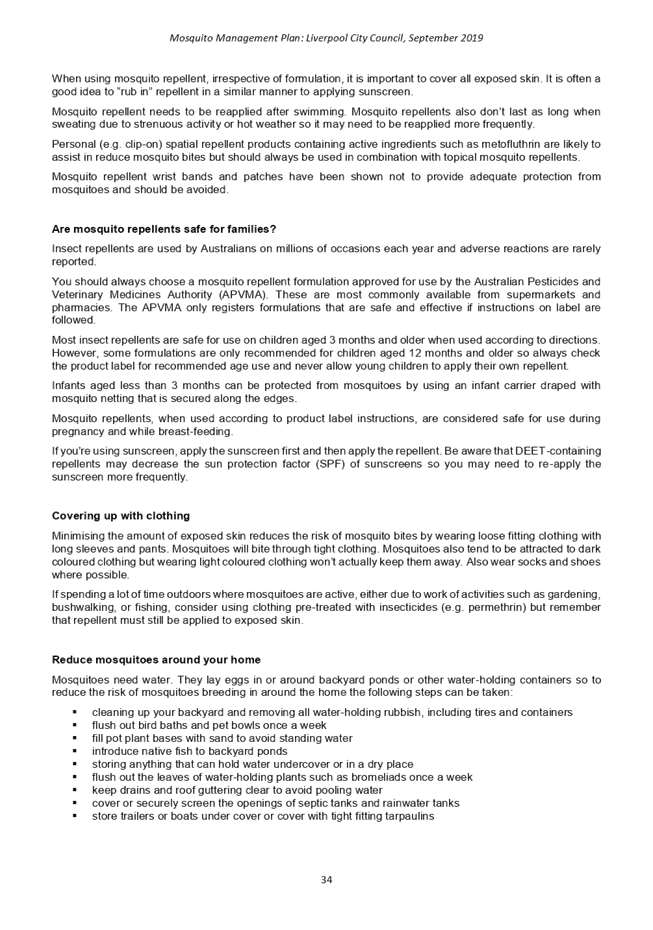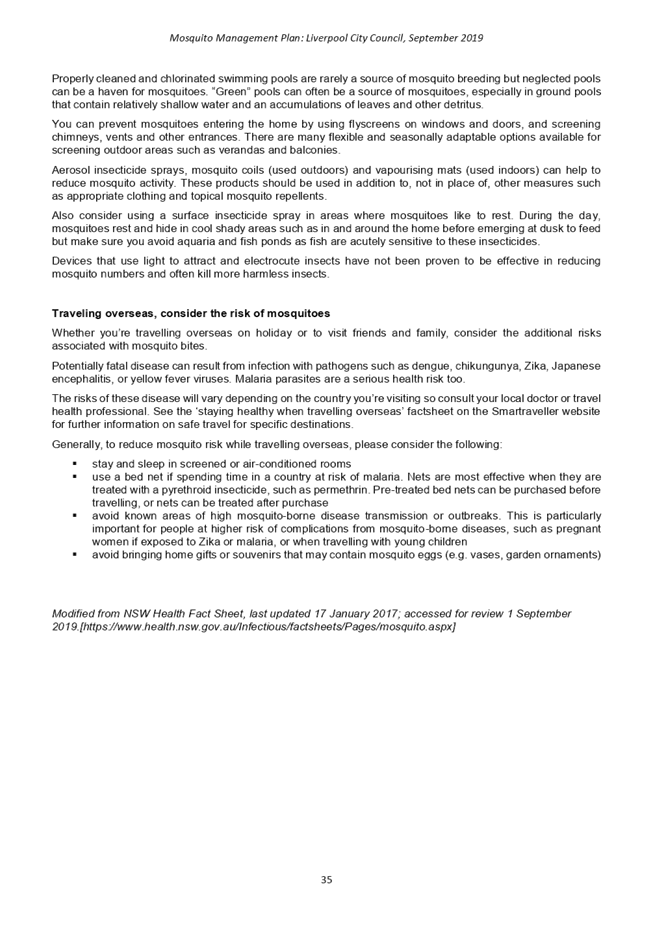Ordinary Meeting 25 September 2019
City Economy and Growth Report
|
EGROW 05
|
Draft Liverpool Contributions Plan 2019
– Austral and Leppington North
|
|
Strategic
Direction
|
Strengthening
and Protecting our Environment
Exercise
planning controls to create high-quality, inclusive urban environments
|
|
File Ref
|
222530.2019
|
|
Report By
|
Barry
Millwood - Strategic Planning Contractor
|
|
Approved
By
|
Tim Moore -
Director, City Economy and Growth / Deputy CEO
|
The
Austral/ Leppington North urban development area has recently undergone a
refresh of the planning controls, as considered by Council at its meeting of 27
March 2019 (EGROW 06). This amendment provided Council with the
opportunity to update specific elements of the accompanying development
contributions plan, particularly as it relates to stormwater management, water
quality and the escalating cost of land and works.
The
draft Liverpool
Contributions Plan 2019 – Austral and Leppington North (refer
to Attachment to be provided as an addendum to the Council business paper)
proposes a rate of $56,097 per lot created. This is an increase of
approximately $500 from the current rate, though this is currently capped at
$30,000. Despite the minor increase, the draft Contributions Plan has
been comprehensively reviewed to ensure that the precinct is supported by a
robust plan that minimises financial risk to Council and provides value for
money to developers and the broader community.
In
addition to addressing the changes included in the most recent amendment to the
SEPP and DCP, the update to the draft Contributions Plan enables Council to
commence the process to incrementally increase the NSW Government imposed cap
on contributions within the precinct. In this regard, the draft Contributions
Plan is consistent with the NSW Government’s latest directions in
relation to contributions, specifically what Council can collect (roads,
drainage, open space, land) and cannot collect (any community facilities, high
level park embellishment).
The
draft Contributions Plan needs to be placed on public exhibition in accordance
with the provisions of the Environmental Planning and Assessment Act and
Regulations. Following exhibition, a report will be prepared for Council
to adopt the contributions plan, subject to any necessary amendments in
response to exhibition. If no submissions are received, the finalisation
of the draft Contributions Plan can be delegated to the CEO.
|
That Council:
1. That Council endorse draft Liverpool
Contributions Plan 2019 – Austral and Leppington North for public exhibition in accordance with the
provisions of the Environmental Planning and Assessment Act, 1979 and Environmental
Planning and Assessment Regulation 2000;
2. Delegate authority to the CEO
to make any typographical or other editing amendments to the draft Liverpool Contributions Plan
2019 – Austral and Leppington North prior
to exhibition if required; and
3. Delegate authority to the CEO
to finalise Liverpool
Contributions Plan 2019 – Austral and Leppington North following its
public exhibition if no submissions are received or report back to Council
the results of any submissions received and how the plan addresses those
submissions.
|
Background
The Austral and Leppington North Precincts were
rezoned by the NSW Government for urban development in March 2013. The
NSW Government controlled the preparation of the Indicative Layout Plan, the
rezoning and the subsequent Development Control Plan all with input from
Council.
The NSW Government also prepared Liverpool
Contributions Plan 2014 - Austral and Leppington North, based on the
Indicative Layout Plan and with input from Council. This contributions
plan came into force on 26 May 2015. Council has been collecting
contributions since that time to fund infrastructure in the precinct.
This contributions plan for the precinct is subject to a cap on contributions
imposed by the NSW Government.
There is a procedure for having the cap progressively
lifted and for recovering foregone funds from the NSW Government. This
begins with preparing a submission to the Independent Pricing and Regulatory
Tribunal (IPART) to obtain an assessment of the contributions plan.
Council has been advised that IPART will only consider a recently made
plan. Accordingly an updated contributions plan for the Austral
Leppington North Precincts has been prepared in conjunction with consultants.
Scope of Contributions Plan
The Draft Contributions Plan would continue to levy contributions
from residential, non-residential, commercial and industrial developments for
the following:
· Local parks (Land and embellishment) (levied on
residential development only);
· Local roads (Land and construction);
· Local drainage (Land and construction of swales and
basins);
· Local community facilities (Land only) (levied on
residential development only); and
· Administration costs.
Council
is bound by a Ministerial Direction which limits the range of facilities that
it may include in the contributions plan. Those facilities which are
excluded from the Draft Contributions Plan include:
· Local community facilities;
· Significant park embellishment;
· Major community facilities (including libraries); and
· Major recreation facilities.
Outline
of changes
Since the current contributions plan came into force a
number of changes have taken place that need to be incorporated into the
version of the plan that will be submitted to IPART. A summary of the key
changes is included below.
Amendments to Indicative Layout Plan
Since the completion of the original Indicative Layout
Plan, some amendments have been proposed by Council as initially reported to
Council at its meeting of 27 June 2018. They included amendments to the
Growth Centres State Environmental Planning Policy (SEPP) 2006 (the land use
zoning plan) and the Development Control Plan (DCP). These amendments
were then endorsed for public exhibition by Council at its meeting of 27 March
2019. Council has recently received Gateway Approval to exhibit the amendments
to the SEPP subject to some conditions.
The changes to the DCP are as follows:
· Some minor adjustments to the street network;
· Deletion of some creek crossings;
· Adjustments to the drainage network arising from a
recent review of the drainage strategy (details below);
· Street cross section design to improve traffic safety
and incorporate water sensitive urban design; and
· Redesign of stormwater quality management controls.
These changes result in some minor changes to the scope
of works in the contributions plan.
Adjustment to the scope of drainage works
Council in 2017 commissioned consultants to review the
drainage strategy for the Austral and Leppington North Precincts and prepare
detailed concept designs for each item of major drainage infrastructure.
The detailed concept designs assists with implementation of land development.
As a result, the following amendments are proposed to
the drainage strategy:
· Deletion of two detention basins;
· Replacement of some drainage channels with pipes;
· Deletion of some road frontages to deleted channels;
and
· Deletion of separate rain gardens (water quality
measures), which are replaced with works in the land subdivision (included in
DCP amendment).
Adjustment to the value of land
Since the adoption of the original contributions plan
in 2015 the value of land has increased substantially. Council, in recent
negotiations for the acquisition of land have experienced substantial increases
in the value of land (determined by the NSW Valuer-General and the Land and
Environment Court), even in excess of the indexed value anticipated by the
current contributions plan.
Revised estimates for the acquisition of englobo land
from independent valuers have now been received and incorporated in the draft
Contributions Plan. The cap on contributions is likely to have
contributed to the increase in the englobo land values.
Despite the general increases in land acquisition
costs across the precinct, the cost of acquisition of flood liable land is expected
to be reduced, as identified in the independent valuers report.
It must be emphasised that the scope of land
acquisition will in fact decline slightly as a result of the revised ILP.
Any increase in land acquisition costs is not as a result of Council seeking to
acquire additional land.
Adjustment to the value of infrastructure
The unit cost of infrastructure other than drainage
has been indexed to today’s values.
The average contribution per conventional lot, if
there was no State imposed cap, under the current contributions plan would be
$55,532. The proposed contribution under the draft Contributions Plan
would be $56,120 per lot.
The main reasons for the change in the per lot
contribution is the increased cost of drainage infrastructure (including land
and works) which is mostly offset by reductions in the acquisition cost of
specific, flood liable land, and the overall number of stormwater structures
required to support the precinct.
Next steps
Exhibition
The next step is to exhibit the draft Contributions
Plan for a period of 28 days. Following exhibition it is anticipated that
a further report on submissions will be submitted for Council’s
determination.
Submission to IPART
Once the revised contributions plan has been adopted a
submission to IPART will be prepared by consultants, familiar with the
requirements of IPART. It is anticipated that IPART will do an initial
assessment of the submission and will have a series of meetings with
Council/our consultants to explore fine detail in all the costings supporting
the Contributions Plan. It is anticipated that this process may take 6
– 12 months.
Once IPART has done an assessment, it will issue a
preliminary report for Council to comment on and then following receipt of
comments, prepare a final report to submit to the Minister for Planning and
Public Spaces.
Ministerial Determination
Once the Contributions Plan has been approved the
Minister will then determine whether to provide gap funding for the value of
contributions foregone due to the cap and whether to alter the cap.
It must be emphasised that any eventual removal of the
cap will not apply to existing consents or new applications once the new
contributions plan has been made. It will only apply to new applications
determined or received after the Minister determines to remove the cap, a
process that has to date involved the cap lifting by $5,000 each year for 2
years before reverting to the full contribution amount.
|
Economic
|
Deliver and maintain a range of transport related infrastructure such
as footpaths, bus shelters and bikeways.
Deliver a high quality local road system including provision and
maintenance of infrastructure and management of traffic issues.
Ensures equity across the precinct in provision of infrastructure to
support the community.
|
|
Environment
|
Manage the environmental health of waterways.
Support the delivery of a range of transport options.
|
Social
|
Provide cultural centres and activities for the enjoyment of the arts.
Provide public communal spaces that support incidental interactions.
|
Civic
Leadership
|
Act as an environmental leader in the community.
Foster neighbourhood pride and a sense of responsibility.
Actively advocate for federal and state government support, funding and
services.
|
|
Legislative
|
Ensures consistency with the Environmental Planning
and Assessment Act, 1979, Environmental Planning And Assessment
Regulation 2000, and relevant planning circulars and directions related
to developer contributions.
|
1. Draft
Liverpool Contributions Plan 2019 - Austral and Leppington North
Ordinary Meeting 25 September 2019
|
PRES 01
|
Mosquito Management Plan
|
|
Strategic
Direction
|
Strengthening
and Protecting our Environment
Develop, and
advocate for, plans that support safe and friendly communities
|
|
File Ref
|
230220.2019
|
|
Report By
|
Kevin Smith
- Acting Manager City Works
|
|
Approved
By
|
Peter
Patterson - Director City Presentation
|
Recently,
mosquito management in many parts of Australia has taken on a regional focus
with collaborative strategies employed by adjacent local governments. For
example in far north NSW a number of councils have formed the Regional Mosquito
Management Group.
Liverpool
City Council (LCC) has initiated the process to facilitate creating a
relationship between various stakeholders along the Georges River and
neighbouring councils. This relationship is in the early stages of
development with commitment from a number of stakeholders to participate in a
working group.
The
warmer weather is approaching and so is the risk from mosquito issues.
While LCC continues to collaborate with stakeholders it has taken the
initiative to engage the Department of Health to prepare a Mosquito Management
Plan for the Liverpool Local Government Area (LGA) for this summer. This
report provides an update on the progress of the working group to date, the
status of the draft mosquito management plan and recommends actions to be
implemented now to address the mosquito risk this summer.
|
That Council:
1. Notes this report on progress with implementing
the mosquito management plan; and
2. Allocates $30,000 in the 2019/2020
Operational Plan to address mosquitoes in Liverpool.
|
Mosquitoes are a natural part of the
Australian environment. They adapt to a wide range of habitats. They are
a food source for birds, bats, fish and frogs but a small number of mosquito
species are serious nuisance-biting pests and vectors of disease-causing
pathogens.
Emerging public health threats can take
many forms. As urbanisation and changing climate influences the local
environment, the pest and public health risks associated with mosquitoes may
rise. Australia experienced one of its worst outbreaks of mosquito-borne
Ross River virus disease on record during 2015. This highlighted the
importance of understanding the connections between mosquitoes, wetlands,
wildlife and human health.
Wetland managers, whether they’re
building wetlands in densely urbanized suburbs or managing existing wetlands,
have a duty of care to ensure both pest and public health risks associated with
mosquitoes are minimised. Mosquitoes will always be active during the
warmer months and local authorities should develop strategic plans to ensure
the local community is not adversely impacted. Like bushfires and floods,
outbreaks of mosquito-borne disease are, essentially, an environmental hazard
that needs to be managed.
Liverpool City Council recently
took the initiative to host a conversation about establishing a working group
to develop a regional mosquito management plan. This meeting was held at our
Depot Operations office on Tuesday 4 June 2019. Representatives from
Canterbury-Bankstown Council, Fairfield City Council, Sutherland Shire Council,
Campbelltown Council, National Parks and Wildlife Service, Sydney Water,
Georges River keeper, Sydney Olympic Park and NSW Health were invited to
attend.
Dr Cameron Webb from NSW Health
presented two papers at this meeting: “Mosquitoes of pest and public
health concern in the Georges River Region” and “Managing
Mosquitos in Georges River Liverpool”. Both presentations highlighted
facts about virus carrying mosquitoes, monitoring programs, community awareness
and the options for establishing a regional mosquito management plan.
On 16 July 2019, LCC invited
all stakeholders to register their support and participation in a working group
to develop a regional mosquito management plan for the Georges River area for
the future. To date, Council has received responses from the following
stakeholders confirming their support:
§ Professor Mark J Ferson
– South Eastern Sydney Public Health
§ Rob Stevenson –
Fairfield City Council
§ David Dekel –
Canterbury Bankstown Council
§ John Birkett –
Liverpool Public Health Unit
§ Beth Salt – Georges
River keeper
§ Jaynia Sladek –
Sutherland Shire Council
LCC is leading this working group and
will arrange regular meetings to discuss and develop resources, including
factsheets that will provide our community a consistent response to concerns
about mosquitoes, while at the same time collaborating with Dr. Webb on a
regional mosquito management plan for the Georges River area.
Stakeholders have registered interest in
participating in the working group, however their role at this stage is limited
to observing until further commitment is received from the NSW State Government
in accepting the leadership role and funding for the development of a regional
management plan.
In the interim, as we await further
assistance/direction from the NSW Government, LCC has taken the opportunity to
engage Dr. Webb to prepare a mosquito management plan proposal specific to the
Liverpool City Council LGA. This plan includes undertaking mapping of the LGA
to identify priority areas and potential control options to target specific
mosquito larvae.
During the 2018/2019 summer, mosquitoes
were identified as a problem at numerous locations across the Liverpool
LGA. The objective of the mosquito management plan is to manage the pest
and public health risks for the coming summer period and beyond.
NSW Health has been engaged by LCC to
prepare a mosquito management plan. A draft report was received on
Thursday 5 September 2019. This report is currently being reviewed.
Even though the report is in draft form,
LCC has enough information to make an informed decision now to ensure proper
strategies are in place to prepare for the summer and the mosquito threat.
To date there has been limited mosquito
monitoring conducted in the Liverpool LGA. As part of the NSW Arbovirus Surveillance
and Mosquito Monitoring Program, the South Western Sydney Local Health District
Public Health Unit has undertaken monitoring in wetlands adjacent to LCC (ie.
Bankstown, Picnic Point). Limited mosquito sampling has also been
undertaken in the suburbs of Liverpool, Cabramatta, Holsworthy, Chipping Norton
and Wattle Grove. Medical Entomology conducted limited mosquito
investigations in the western areas of LGA around the suburb of
Luddenham. Site inspections were also undertaken in estuarine wetlands
adjacent to the suburbs of Voyager Point and Hammondville in early August
2019. This information has been used to form the conclusions in the
report and its action plan.
The report states:
“There is often broad
reference to Georges River and associated estuarine wetlands as sources of pest
mosquitoes. However, due to the topography of the river adjacent to LCC,
the primary sources of mosquitoes are those mangrove, saltmarsh, and she-oak
woodland habitats downstream alongside the suburbs of Chipping Norton,
Hammondville and Voyager Point. Upstream from these areas, the banks of
the river become steep and/or heavily developed and there is relatively little
wetland available for major pest mosquitoes. While there may be small
pockets of wetlands where mosquitoes are present, their abundance will remain
relatively low or only infrequently abundant.
Within LCC, the highest
priority areas for mosquito control are the estuarine and brackish water
wetlands adjacent to the suburbs of Hammondville and Voyager Point. In
reviewing the LCC vegetation maps and coastal management zones, and in
combination with surveys of wetlands in July 2019, it appears that the highest
risk areas are shoe-oak woodlands adjacent to Lieutenant Cantello Reserve,
Hammondville. While there are areas of saltmarsh, sedgeland, and
mangroves nearby in Voyager Point, there is no conclusive evidence yet that
these areas pose a significant risk of producing large populations of Aedes
vigilax and control is not currently recommended for this area.”
The Mosquito Management plan is still in
draft format, it will be endorsed by the CEO as an operational plan.
MOSQUITO MANAGEMENT STRATEGY
There are nine key strategies
in the Action Plan. They are;
1. Initiate participation with NSW Arbovirus
Surveillance and Mosquito Monitoring Program.
2. Identify mosquito control priority
sites.
3. Create mosquito risk maps of key
habitats within the LCC LGA.
4. Target mosquito control activities.
5. Take lead role in regional mosquito
management working group.
6. Review local public education
material.
7. Stormwater management.
8. Natural resource management.
9. Mosquito research projects.
All the strategies should be supported.
However, the three strategies that must
be implemented now for the coming summer are:
1. Surveillance
While local government is
responsible for the setting and collection of mosquito traps, the NSW Arbovirus
Surveillance and Mosquito Monitoring Program facilitates the identification of
mosquito specimens, testing for pathogens and provision of reports.
It is recommended that LCC
participate in the surveillance program and purchase 2 traps for placement at
Hammondville / Voyager Point and Chipping Norton. The collection program
is from December to April.
2. Mosquito Management
Habitats associated with the
Georges River foreshore at Hammondville have been identified as high risk
areas. Judicious use of mosquito control agents is required and between
4-6 treatments are required from November to March.
3. Public Education Programs
A framework for communicating
issues regarding mosquito and mosquito borne disease awareness, together with
information about personal protection measures to be used against mosquitoes
has been provided and requires implementation.
An opportunity exists for LCC to take a
lead role in the formation of a working group of local and state government
organisations and other stakeholders, to address the mosquito issues facing the
community along the Georges River. Such a group of contiguous authorities
would be well placed to collaboratively better manage the pest and public
health risk associated with local mosquitoes in cost effective ways. LCC
will continue to pursue this opportunity.
|
Economic
|
Explore a regional approach to mosquito management to improve the
effectiveness of plans.
A regional approach allows cost savings to be achieved.
A regional approach allows a specific focus to be given to mosquito
related issues.
|
|
Environment
|
Decrease the risk to public health from
mosquitoes.
Adopt mosquito control agents that are
registered for use in estuarine wetlands.
Do not use control agents in natural
environments if there is a potential to have non-target impacts.
|
Social
|
Decrease the potential for mosquitoes to
impact on the comfort and experiences of those living or undertaking
recreational activities.
Provide education programs to inform the
community of protection measures and public health risks from mosquitoes.
|
Civic
Leadership
|
Take the lead role in a regional mosquito
management working group.
|
|
Legislative
|
There are no legislative considerations
relating to this report.
|
1. Mosquito
Management Plan - Liverpool City Council
![]()





































